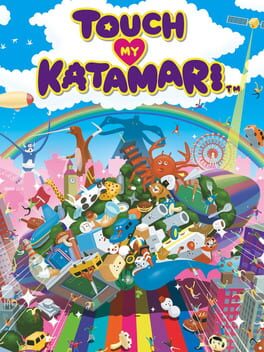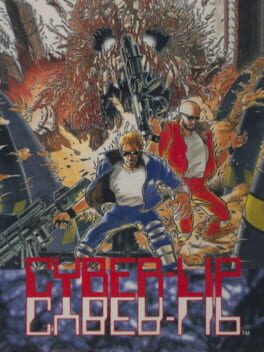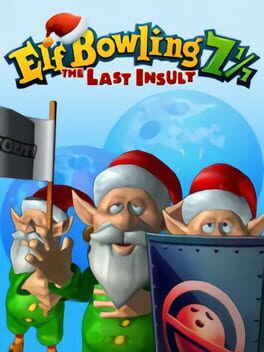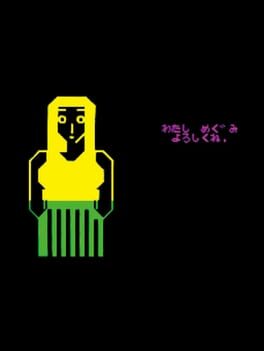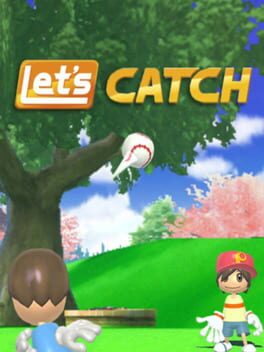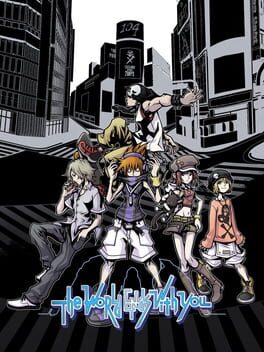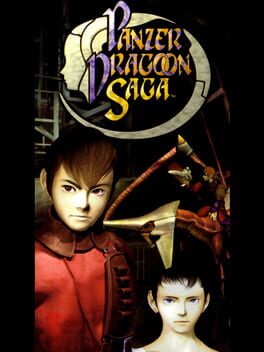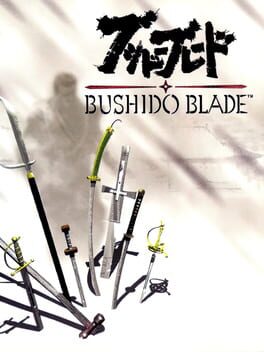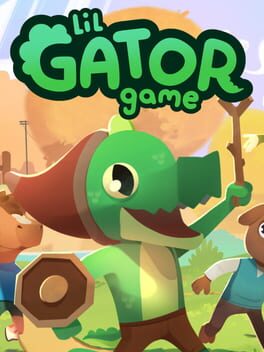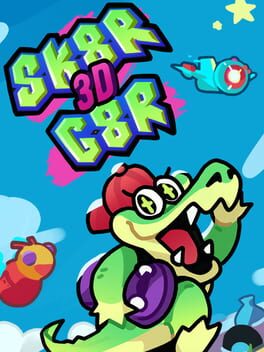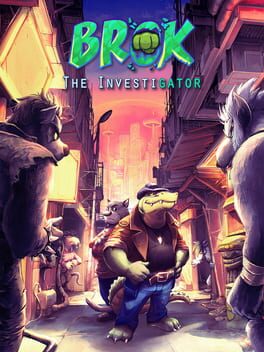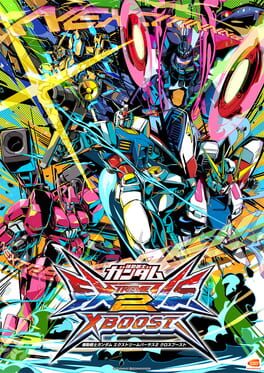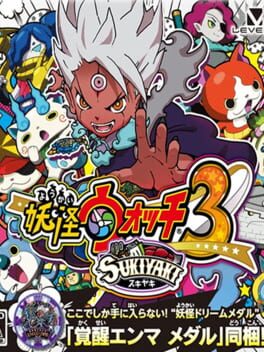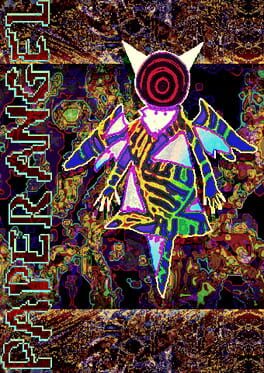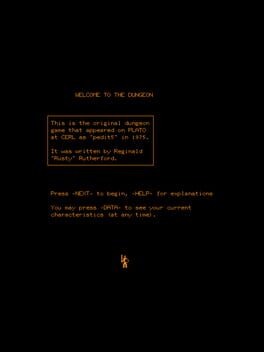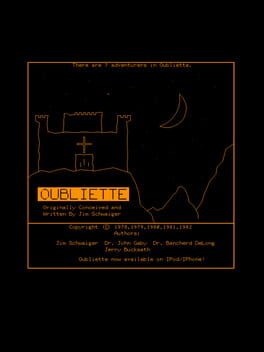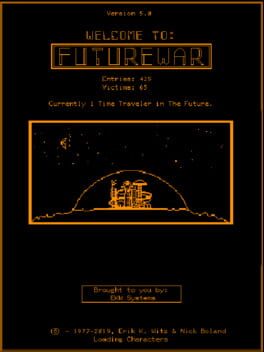roc
20 reviews liked by roc
Doctor Hauzer
1994
Been wanting to play this for years, albeit more as a fan of the PS1 title Overblood (which was made by the same folks behind this) than someone delving into the history of 90s survival horror games. It's also my first time playing a 3DO game, and hopefully I'll be doing more of that in the future now that I've got the 4DO emulator.
This game's quite cool, though it's funny how short it is. I always assumed people were sorta exaggerating when talking about its length, but no, it's a really brisk game you can beat in an hour. Admittedly, that's also something of a feather in its cap since you don't have to invest so much time into it, whether on your first go or upon replays.
It's got a variety of neat tactile puzzles where you examine the environment and use items you pick up to solve problems; I'm a sucker for those kinds of puzzles in adventure games, which is partially why I gravitate more towards the fully 3D style of 90s adventure gaming where this sort of thing was fairly common.
The only thing I don't really like is that the base framerate is maddeningly slow. I normally don't care about slow framerate, especially in games that are already sedate to begin with. But depending on the room you're in, the game can chug so hard that it makes trying to turn or move around an absolute arseache. I had to resort to overclocking the CPU after a few minutes just so I wasn't getting frustrated at the slog.
On a more positive note, playing this helped me to appreciate how Overblood basically carried over a lot of what this game was doing (even down to the different camera types you can switch between to better navigate places), and expanded on those ideas with the dual-character setup, a more in-depth plot, scenarios where you have to respond in time, and combat encounters.
It's a cool little adventure game, and one I'm chuffed to have finally gotten round to. : )
This game's quite cool, though it's funny how short it is. I always assumed people were sorta exaggerating when talking about its length, but no, it's a really brisk game you can beat in an hour. Admittedly, that's also something of a feather in its cap since you don't have to invest so much time into it, whether on your first go or upon replays.
It's got a variety of neat tactile puzzles where you examine the environment and use items you pick up to solve problems; I'm a sucker for those kinds of puzzles in adventure games, which is partially why I gravitate more towards the fully 3D style of 90s adventure gaming where this sort of thing was fairly common.
The only thing I don't really like is that the base framerate is maddeningly slow. I normally don't care about slow framerate, especially in games that are already sedate to begin with. But depending on the room you're in, the game can chug so hard that it makes trying to turn or move around an absolute arseache. I had to resort to overclocking the CPU after a few minutes just so I wasn't getting frustrated at the slog.
On a more positive note, playing this helped me to appreciate how Overblood basically carried over a lot of what this game was doing (even down to the different camera types you can switch between to better navigate places), and expanded on those ideas with the dual-character setup, a more in-depth plot, scenarios where you have to respond in time, and combat encounters.
It's a cool little adventure game, and one I'm chuffed to have finally gotten round to. : )
Touch My Katamari
2011
Cyber-Lip
1990
Following the Clinton-Lewinsky scandal of 1998, Dallas-based NVision Design emailed their first Macromedia Flash project, Good Willie Hunting to 200 people on April Fools Day of that year. The small 1.4MB file garnered 5,000,000 downloads and 300,000 site visits by October, quickly cementing NVision Design as self-proclaimed proprietors of "aggressive design for the internet and traditional mediums."¹ As an early advergame, Good Willie Hunting was plastered with the creators' creed, website, and contact information, and the company quickly found themselves contracted the likes of AT&T, Miller Brewing Company, Texas Instruments, and Lucent Technologies.² Subsequent releases Good Willie Speaks, Y2K - The Game, and Frogapult kept the clients rolling in and the site views climbing. The December 1999 release of Elf Bowling would be where NVision Design truly exploded in popularity however.
It's critical to know that at this time in the Internet's relative infancy, .exe files (among other filetypes) could not be removed from email strings, hence the popularity of these small programs when they were sent en masse. Their proliferation made them a ripe target for fictitious claims of them being viruses. Around December 8, 1999, email strings and usenet posts on the alt.comp.virus newsgroup stated that Frogapult, Y2K - The Game, and Elf Bowling contained "a delayed virus attached to them that will be activated on Christmas day and will wipe out your system. Let everyone know of this."³ A similar hoax email proffered:
"If you have received Elf Bowling or Frogapult games that have been circulating the Internet, or know anyone who has, they must be deleted before Christmas day. They contain viruses that are set to go off on Christmas day and will delete your hard drive. If you don't believe me, just wait and see. Our IT guy here just tested it on a non-networked PC and everything was wiped out. Make certain that every copy is off of your hard drive or any servers. Please spread the world. These games are very detrimental to your computing life."⁴
This was quickly disproved by Symantec's AntiVirus Research Center, but that didn't stop the name of NVision Design's titles from spreading even further. If anything, the notion of such innocuous games - particularly Elf Bowling - harbouring malicious intent made them a great curiousity, particularly when they were demonstrated to be safe.⁵ It isn't as if the claims were entirely spurious, however, as email-distributed viruses had wreaked havoc previously in cases like 'Melissa,' and NVision's games in particular accessed their servers without express permission from the user (only to upload high scores and perform very basic analytics, but the point remained).⁶ Regardless of its safety, the risk in opening a random program sent to you without your consent that would unknowingly make an outside connection was immense.⁷ As such, when the virus claims turned out to be a hoax, the media looped back around on NVision Design by labelling games like Elf Bowling as potential spyware, a claim which was adamantly fought against by the company as per their official correspondence.⁸ Even today, Elf Bowling is labelled as spyware on TechTarget's site in a definition article updated in July 2021.⁹
Ultimately, Elf Bowling was and is simply a juvenile time waster which exploded in popularity to the point where the mainstream media audaciously claimed by 2001 that it was bigger than Quake or Doom.¹⁰ The gameplay couldn't be simpler and everything about it is so cheesy that it's almost charming. It received an astonishing number of sequels, the majority of which weren't bowling at all. Elf Bowling 2: Elves in Paradise is a shuffleboard game. Elf Bowling 3 is a target shooting game. Super Elf Bowling returned to the series' roots only for Elf Bowling: Bocce Style to once again veer off course. Elf Bowling 6: Air Biscuits bears similarities to Elf Bowling in that elves are to be knocked down, but this time these pin-replacements have another elf thrown at them rather than a bowling ball.
With Elf Bowling 7 1/7: The Last Insult, 'true' bowling gameplay returns, this time with powerups and powerdowns and a method of control that has you spinning your ball as it rolls down the lane, a la HyperEntertainment's HyperBowl Plus! or Skunk Studios' Gutterball 2. And you know what, it ain't half-bad! The items are largely irrelevant since you can either avoid them or counter them with your own powerups, but it plays fine. And when you get a strike the game slows down to comical levels as it shows the elves launching like you're playing BeamNG.drive and want to relish those softbody physics. I'll have to save the remainder of my paltry 43 remaining minutes in the trial version for when I want to play some more of this, which will probably be never.
Recommended by Nightblade as part of [this list]
1. "NStorm Takes Internet By Storm," NStorm, archived October 18, 2000, http://www.nstorm.com/whatis/willie.html. Archived at https://web.archive.org/web/20001018131151/http://www.nstorm.com/whatis/willie.html.
2. Abby Miller, “NVision Makes a Game of Better Marketing,” DMNews, November 7, 2007, https://www.dmnews.com/nvision-makes-a-game-of-better-marketing/.
3. Motoaki Yamamura, "FROGAPULT, ELFBOWL, Y2KGAME Virus Hoax," Symantec AntiVirus Research Center, Symantec, publication date December 8, 1999, archived February 29, 2000, http://symantec.com/avcenter/venc/data/y2kgame.hoax.html; Archived at https://web.archive.org/web/20000229230522/http://symantec.com/avcenter/venc/data/y2kgame.hoax.html; “Frogapault Warning (Hoax?),” Google Groups (Google, December 9, 1999), https://groups.google.com/g/alt.comp.virus/c/CLa9zFjBMEA/m/Lu1RDeqcOGMJ. “Elfbowling Virus,” Google Groups (Google, December 9, 1999), https://groups.google.com/g/alt.comp.virus/c/Rwwlfwu5hPM/m/paYcVzz04GsJ; “Possible Trojan in Elf-Bowling Game,” Google Groups (Google, December 7, 1999), https://groups.google.com/g/alt.comp.virus/c/Qmcqg8Co6ME/m/goVFGgq3Y7kJ; Evan Hansen, “Vectrix.com Acquires Creator of Frogapult,” CNET (CNET, January 3, 2002), https://www.cnet.com/tech/services-and-software/vectrix-com-acquires-creator-of-frogapult/.
4. “Elf Bowling Virus.html,” Scambusters, November 25, 2020, https://scambusters.org/elf-bowling.html, quoted in H. Thomas Milhorn, Cybercrime: How to Avoid Becoming a Victim, (Boca Raton, FL: Universal Publishers, 2007), 284.
5. Fw: FROGAPULT, ELFBOWL, Y2KGAME virus hoax, accessed September 11, 2022, http://www.enron-mail.com/email/bass-e/all_documents/Fw_FROGAPULT_ELFBOWL_Y2KGAME_Virus_Hoax_1.html.
6. Dan Briody, CNN (Cable News Network, March 29, 1999), http://www.cnn.com/TECH/computing/9903/29/melissa.idg/.
7. Ernie Smith, “Elf Bowling Game History: It's Not a Virus. It's Not Spyware.,” Tedium, December 21, 2017, https://tedium.co/2017/12/21/elf-bowling-history/; Heidi Prescott, “Truths: No Santa's Elf Virus, No Free Stuff,” South Bend Tribune, December 13, 1999, sec. Personal Technology, p. 16.
8. Ernie Smith, “Elf Bowling Game History: It's Not a Virus. It's Not Spyware.,” Tedium, December 21, 2017, https://tedium.co/2017/12/21/elf-bowling-history/; “Elf Bowling,” Elf bowling (NVision Design, November 1999), https://www.geocities.ws/Colosseum/Court/7685/elfbowl.html#privacyconcern; David Wilson, “E-Mailed Game Secretly Connects Private PCs to Firm: Bowling Santa Knocks down User's Privacy,” The Ottawa Citizen, December 27, 1999, sec. High Tech Report, p. B5.
9. Ernie Smith, “Elf Bowling Game History: It's Not a Virus. It's Not Spyware.,” Tedium, December 21, 2017, https://tedium.co/2017/12/21/elf-bowling-history/; Alexander S. Gillis, Kate Brush, and Taina Teravainen, “What Is Spyware?,” SearchSecurity (TechTarget, July 13, 2021), https://www.techtarget.com/searchsecurity/definition/spyware.
10. itzaferg, “Elf Bowling Fox News Interviews Elf Bowling Creators,” YouTube (YouTube, August 3, 2014), https://www.youtube.com/watch?v=pD3nBXwPjRg; LGR, "Elf Bowling: "Bigger Than Quake or Doom!,"" YouTube (YouTube, December 5, 2016), https://www.youtube.com/watch?v=28TyIsCwkQo.
It's critical to know that at this time in the Internet's relative infancy, .exe files (among other filetypes) could not be removed from email strings, hence the popularity of these small programs when they were sent en masse. Their proliferation made them a ripe target for fictitious claims of them being viruses. Around December 8, 1999, email strings and usenet posts on the alt.comp.virus newsgroup stated that Frogapult, Y2K - The Game, and Elf Bowling contained "a delayed virus attached to them that will be activated on Christmas day and will wipe out your system. Let everyone know of this."³ A similar hoax email proffered:
"If you have received Elf Bowling or Frogapult games that have been circulating the Internet, or know anyone who has, they must be deleted before Christmas day. They contain viruses that are set to go off on Christmas day and will delete your hard drive. If you don't believe me, just wait and see. Our IT guy here just tested it on a non-networked PC and everything was wiped out. Make certain that every copy is off of your hard drive or any servers. Please spread the world. These games are very detrimental to your computing life."⁴
This was quickly disproved by Symantec's AntiVirus Research Center, but that didn't stop the name of NVision Design's titles from spreading even further. If anything, the notion of such innocuous games - particularly Elf Bowling - harbouring malicious intent made them a great curiousity, particularly when they were demonstrated to be safe.⁵ It isn't as if the claims were entirely spurious, however, as email-distributed viruses had wreaked havoc previously in cases like 'Melissa,' and NVision's games in particular accessed their servers without express permission from the user (only to upload high scores and perform very basic analytics, but the point remained).⁶ Regardless of its safety, the risk in opening a random program sent to you without your consent that would unknowingly make an outside connection was immense.⁷ As such, when the virus claims turned out to be a hoax, the media looped back around on NVision Design by labelling games like Elf Bowling as potential spyware, a claim which was adamantly fought against by the company as per their official correspondence.⁸ Even today, Elf Bowling is labelled as spyware on TechTarget's site in a definition article updated in July 2021.⁹
Ultimately, Elf Bowling was and is simply a juvenile time waster which exploded in popularity to the point where the mainstream media audaciously claimed by 2001 that it was bigger than Quake or Doom.¹⁰ The gameplay couldn't be simpler and everything about it is so cheesy that it's almost charming. It received an astonishing number of sequels, the majority of which weren't bowling at all. Elf Bowling 2: Elves in Paradise is a shuffleboard game. Elf Bowling 3 is a target shooting game. Super Elf Bowling returned to the series' roots only for Elf Bowling: Bocce Style to once again veer off course. Elf Bowling 6: Air Biscuits bears similarities to Elf Bowling in that elves are to be knocked down, but this time these pin-replacements have another elf thrown at them rather than a bowling ball.
With Elf Bowling 7 1/7: The Last Insult, 'true' bowling gameplay returns, this time with powerups and powerdowns and a method of control that has you spinning your ball as it rolls down the lane, a la HyperEntertainment's HyperBowl Plus! or Skunk Studios' Gutterball 2. And you know what, it ain't half-bad! The items are largely irrelevant since you can either avoid them or counter them with your own powerups, but it plays fine. And when you get a strike the game slows down to comical levels as it shows the elves launching like you're playing BeamNG.drive and want to relish those softbody physics. I'll have to save the remainder of my paltry 43 remaining minutes in the trial version for when I want to play some more of this, which will probably be never.
Recommended by Nightblade as part of [this list]
1. "NStorm Takes Internet By Storm," NStorm, archived October 18, 2000, http://www.nstorm.com/whatis/willie.html. Archived at https://web.archive.org/web/20001018131151/http://www.nstorm.com/whatis/willie.html.
2. Abby Miller, “NVision Makes a Game of Better Marketing,” DMNews, November 7, 2007, https://www.dmnews.com/nvision-makes-a-game-of-better-marketing/.
3. Motoaki Yamamura, "FROGAPULT, ELFBOWL, Y2KGAME Virus Hoax," Symantec AntiVirus Research Center, Symantec, publication date December 8, 1999, archived February 29, 2000, http://symantec.com/avcenter/venc/data/y2kgame.hoax.html; Archived at https://web.archive.org/web/20000229230522/http://symantec.com/avcenter/venc/data/y2kgame.hoax.html; “Frogapault Warning (Hoax?),” Google Groups (Google, December 9, 1999), https://groups.google.com/g/alt.comp.virus/c/CLa9zFjBMEA/m/Lu1RDeqcOGMJ. “Elfbowling Virus,” Google Groups (Google, December 9, 1999), https://groups.google.com/g/alt.comp.virus/c/Rwwlfwu5hPM/m/paYcVzz04GsJ; “Possible Trojan in Elf-Bowling Game,” Google Groups (Google, December 7, 1999), https://groups.google.com/g/alt.comp.virus/c/Qmcqg8Co6ME/m/goVFGgq3Y7kJ; Evan Hansen, “Vectrix.com Acquires Creator of Frogapult,” CNET (CNET, January 3, 2002), https://www.cnet.com/tech/services-and-software/vectrix-com-acquires-creator-of-frogapult/.
4. “Elf Bowling Virus.html,” Scambusters, November 25, 2020, https://scambusters.org/elf-bowling.html, quoted in H. Thomas Milhorn, Cybercrime: How to Avoid Becoming a Victim, (Boca Raton, FL: Universal Publishers, 2007), 284.
5. Fw: FROGAPULT, ELFBOWL, Y2KGAME virus hoax, accessed September 11, 2022, http://www.enron-mail.com/email/bass-e/all_documents/Fw_FROGAPULT_ELFBOWL_Y2KGAME_Virus_Hoax_1.html.
6. Dan Briody, CNN (Cable News Network, March 29, 1999), http://www.cnn.com/TECH/computing/9903/29/melissa.idg/.
7. Ernie Smith, “Elf Bowling Game History: It's Not a Virus. It's Not Spyware.,” Tedium, December 21, 2017, https://tedium.co/2017/12/21/elf-bowling-history/; Heidi Prescott, “Truths: No Santa's Elf Virus, No Free Stuff,” South Bend Tribune, December 13, 1999, sec. Personal Technology, p. 16.
8. Ernie Smith, “Elf Bowling Game History: It's Not a Virus. It's Not Spyware.,” Tedium, December 21, 2017, https://tedium.co/2017/12/21/elf-bowling-history/; “Elf Bowling,” Elf bowling (NVision Design, November 1999), https://www.geocities.ws/Colosseum/Court/7685/elfbowl.html#privacyconcern; David Wilson, “E-Mailed Game Secretly Connects Private PCs to Firm: Bowling Santa Knocks down User's Privacy,” The Ottawa Citizen, December 27, 1999, sec. High Tech Report, p. B5.
9. Ernie Smith, “Elf Bowling Game History: It's Not a Virus. It's Not Spyware.,” Tedium, December 21, 2017, https://tedium.co/2017/12/21/elf-bowling-history/; Alexander S. Gillis, Kate Brush, and Taina Teravainen, “What Is Spyware?,” SearchSecurity (TechTarget, July 13, 2021), https://www.techtarget.com/searchsecurity/definition/spyware.
10. itzaferg, “Elf Bowling Fox News Interviews Elf Bowling Creators,” YouTube (YouTube, August 3, 2014), https://www.youtube.com/watch?v=pD3nBXwPjRg; LGR, "Elf Bowling: "Bigger Than Quake or Doom!,"" YouTube (YouTube, December 5, 2016), https://www.youtube.com/watch?v=28TyIsCwkQo.
Yakyuuken
1969
I Uncovered the First Eroge Ever and it’s THIS?? (LOST MEDIA!!!) 😱
(Available on Bump Combat with photo accompaniment)
(Also on Gaming Alexandria)
One year ago, after weeks of intensive research, I put together a culmination of available knowledge on dB-Soft’s notorious, under-documented 177. My intent was for this to be the first of many projects detailing the cultural role and history of key eroge works. My research into 177 bore fruit for seemingly countless historical forays into the likes of Lover Boy, Lolita Syndrome, Night Life, and Emmy. Information on these titles was somewhat scant to be sure, but there was enough to construct a narrative. Lover Boy was knocked out in a couple days, and in revisiting my list of potential topics I was intrigued by a title I’d popped on there without much thought:
Yakyūken (Hudson Soft, n.d.)
Supposedly this predated Koei’s Night Life and even On-Line Systems’ Softporn Adventure by quite some margin, though the specific date was up for debate if not entirely lost. If I were to talk about PSK’s Lolita: Yakyūken at some point, surely it would make more sense to tackle its progenitor first. This presented a few problems. First, there is not exactly a plethora of information about this primitive eroge. Second, it seems to have left no impact. Third, there was no way to play it. For all I knew, Yakyūken did not even exist in the first place, and if it had, nobody had bothered to back it up. VGDensetsu had collated some basic information and screenshots,[1] and BEEP had acquired a copy in 2015,[2] but these only served to tease me, increasing my appetite for forbidden fruit. The type-in version printed in MZ-700 Joyful Pack only had one page of the code documented online, and a search of previous Yahoo! Auctions listings for either cassette came up empty. But MZ-700 Joyful Pack seemed to turn up frequently, that seemed the best course of action.
Unwilling to wait for it to be listed on Yahoo! Auctions again, I turned to Kosho, Japan’s secondhand bookstore search engine. Finding one listing, without a picture, I took a gamble on a copy of what appeared to be the right issue of MZ-700 Joyful Pack, and patiently waited. A month later, it arrived at my door, and while it looked different from the one I had seen online, I excitedly opened it up, flipping through each page for my treasure. Were I looking into computerised Shogi, Go, and Mahjong, I would have found it. Every type-in was a trainer, solver, or some other supplementary program for these three Japanese board games. The trail turned ice cold. Distraught, I resigned myself to searching Yahoo! Auctions weekly for the correct MZ-700 Joyful Pack or a Yakyūken cassette. After another month, the same tape I had seen on BEEP popped up; HuPack #2 for Sharp MZ-700.
Forty years old. Dirty. Discoloured. Untested. I set up my bid in a panic, shaking with anticipation for the next four days, pleading nobody would top my already high bid. I won, it reached my proxy after a week, it was on its way. Quaking as a leaf in a stiff wind, it arrived. Quickly it dawned on me my tape deck had been broken for years, but some kind folks at Gaming Alexandria thankfully offered to dump and scan it on my behalf.[3] After many months of searching, this seemingly lost progenitor to the entirety of erotic gaming was available again. Nobody particularly cared, but I had the first piece of the puzzle I needed. Tape back in hand, I imported a copy of Miyamoto Naoya’s seminal Introduction to Cultural Studies: Adult Games, the first edition of Bishōjo Game Maniax, Sansai Books’ 35 Years of Bishōjo Game History, and Maeda Hiroshi’s Our Bishōjo Game Chronicle, the only books I could source that made mention of Yakyūken.
Only problem was, what exactly is Yakyūken. Why are we stripping while playing rock paper scissors in the first place?
On the Origins of Rock Paper Scissors
Though now effectively ubiquitous across a multitude of cultures, rock paper scissors type hand games (ken) have enjoyed an astounding popularity in Japan since the eighteenth century. Brought to Japan from China sometime before 1743, the original form of Japanese ken is referred to today as kazu-ken, Nagasaki-ken, and hon-ken (“original ken”). Players sat opposite one another, showed any number of fingers on their right hand, and called out a guess as to what the sum of the fingers would be. The left hand counted one’s wins, and the loser of a set was made to drink a cup of sake. With its specific hand movements, Chinese mode of calling numbers, and embedded rules of drinking, kazu-ken flourished in the red-light district of Yoshiwara.[4] Its exoticism in the time of sakoku and Japanese Sinophilia no doubt contributed to its proliferation. However, the theatrics and, as Japanologist Sepp Linhart argues, ritualistic rules made the game difficult to penetrate for those not in the know, a far cry from the rock paper scissors we know today.[5]
Subsequent iterations of ken remedied the complications through the familiar sansukumi-ken (“ken of the three which cower one before the other”) format.[6] A wins over B, B over C, C over A. In its first iteration, mushi-ken, the frog (represented by the thumb) defeated the slug (the pinkie) which won over the snake (index finger). Itself another cultural import from China, mushi-ken gradually acquired a reputation as a game explicitly for children[7], but what won over it culturally was kitsune-ken, later Touhachi-ken. The kitsune trumps the head of the village which wins over the hunter which kills the kitsune. This two-handed ken was more popular among adults in and out of districts like Yoshiwara, particularly as the basis for libations or stripping.[8] The accompanying song, dance, and act of playing kitsune-ken as a strip-game were known as chonkina, the loser doffing an article of clothing until one was bare. Clearly intended for adult entertainment, chonkina nonetheless made itself known to children in time, as recalled in Shibuzawa Seika’s Asakusakko:
"Two children, standing opposite to each other, after having put together the palms of their hands right and left as well as alternately, finally make one of the postures of fox, hunter or village headman to decide a winner. The loser has to put off a piece of what he is wearing every time, until one of them is stark naked. To see the little children on cold winter days trembling, because one after another piece of cloth was stripped them off is a strange scene which can no longer be seen today."[9]
As the nation opened to foreigners again, chonkina became well known among foreigners, and due to the bad reputation it was bestowing to Japan, it was outlawed from September 1894 onward.[10]
Children’s mushi-ken would go on to evolve into jan-ken, the rock paper scissors with which we are familiar, but the specifics of when and how are unclear and unimportant for our purposes. Jan-ken was the preeminent ken by the end of the Meiji period, and ken on the whole was relegated to the realm of children. However, as a game intimately familiar to nearly all Japanese beyond childhood, the simple, fast-paced trichotomy of jan-ken, alongside its association with punishment systems like drink and stripping afforded jan-ken staying power beyond childhood.[11] It is a game which effectively boils down to luck, allowing for decision-making that, if nothing else, is understood to be fair.
Putting the Yakyū in Yakyūken
It’s October, 1924 in Takamatsu. To break in the new ground at Yashima, nearby industrial companies and technical schools are holding a baseball tournament. In a crushing defeat of 0-8, the team from Iyo Railway (later Iyotetsu) was humiliated by the Kosho Club, composed of students from Kagawa Prefectural Takamatsu Commercial School (now Kagawa Prefectural Takamatsu Commercial High School). [12] Later that night, the teams held a get-together at a nearby ryokan, putting on enkai-gei (“party tricks”). Manager of the Iyotetsu team and senryū poet, Goken Maeda, devised an arrangement and choreography of the 1878 nagauta piece “Genroku Hanami Odori.” The Iyotetsu team danced to shamisen in their uniforms to the delight of those in attendance. This first iteration of what would become Yakyūken (literally “baseball fist”) was based on the Japanese rock paper scissors variant kitsune-ken, but by 1947 it came to reflect now common variant jan-ken.[13] The Yakyūken performance was repeated at a consolation party in Iyotetsu’s hometown of Matsuyama, quickly gaining popularity therein and throughout Japan as the team performed it while on tour.[14]
The camaraderie instilled in audiences by the Iyotetsu team’s dance, and its spread as enkai-gei, led to many localised instances of this new form of jan-ken being performed.[15] The specifics of how prevalent it became are impossible to discern, but what is known is that Yakyūken, as with the earlier kazu-ken and kitsune-ken, became another diversion used as an excuse to imbibe and to disrobe.
野球するならこういう具合にしやしゃんせ ~ソラ しやしゃんせ~
投げたら こう打って 打ったなら こう受けて
ランナーになったらエッサッサ ~アウト・セーフヨヨイノヨイ~
It’s 1954. Contemporary Ryūkōka artists Ichiro Wakahara and Terukiku of King Records,[16] Yukie Satoshi and Kubo Takakura of Nippon Columbia,[17] and Harumi Aoki of Victor Japan[18] have all released 78 rpm singles with their own takes on Yakyūken. This musical multiple discovery of a still relatively local song brought into question where it had actually originated, with a photograph of the Matsuyama consolation party cementing Goken Maeda as its creator.[19] With this, Maeda’s original, non-chonkina song and dance came to be understood as honke Yakyūken, the orthodox iteration, the way it was meant to be. As the dance spread, alcohol flowed and clothes were shed. In an attempt to preserve the sanctity of Maeda’s phenomenon, fellow poet Tomita Tanuki established an iemoto system for honke Yakyūken around 1966, formalising its lyrical structure and attempting to preserve Yakyūken as a way, not unlike sumo. As iemoto, Tanuki in effect declared himself to be the highest authority on honke Yakyūken — it did not and would not matter how Yakyūken was actually enjoyed colloquially, only what the iemoto approved of constituted the real thing. At the same time, the city of Matsuyama introduced a new taiko performance — the Iyo-no-Matsuyama Tsuzumi Odori — for that year’s Matsuyama Odori festival. While it was popular, it lacked regionalism, and so in 1970, it was replaced with Yakyūken Odori.[20] It wasn’t just local flavour, however, as the year prior Yakyūken became a national phenomenon for more unsavoury reasons.
Birth of a Sensation: Yakyūken Breaks Into the Mainstream, or Tits Out for TV
Just as in the United States, the 1960s in Japan were marked by an increase in individuals’ buying power and the proliferation of television. Whereas the prior decade relegated television sets to the homes of the wealthy or in street-side display windows, by 1970, 90% of Japanese households owned at least one television set.[21] The penetration of the entertainment sphere into the domestic realm led to a berth of variety and comedy shows, all emphasising the joys of laughter. This proliferation rose concerns among cultural critics in the 1960s, with fears that the often lowbrow, thoughtless humour which frequently lampooned violence and sexuality were unsuited to the home, particularly where children might be watching.[22] Furthermore, such programming was becoming increasingly rote and prescriptive in its approach, thereby lessening its effect with each broadcast, making this new mode of entertainment lascivious and boring. In breaking free of an ever rigid mould, Japanese television’s saviour came in the form of Hagimoto Kinichi and Sakagami Jirō’s comedy duo Konto 55-gō. Pronounced as “konto go-jyuu go gō,” the name’s syllabic tempo, evocation of go-go dancing, and abstruse referencing of baseball player Oh Sadaharu’s 55th homerun of the 1964 season all brought about a rapidity and contemporary sensibility fitting of the pair’s comedic stylings.[23]
From their television debut in 1967, Konto 55-gō demonstrated a dynamic physicality in stark contrast to similar acts, often moving so fast that cameras could not keep up with them, the laughter of the audience sometimes being the only indicator of a punchline’s delivery.[24] While a breath of fresh air, cultural critics lambasted this seeming over-correction as yet again inappropriate for home audiences. On the other hand, audiences adored the duo’s comedy, with renowned Buddhist nun, translator of Genji Monogatari into modern Japanese, and self-described Konto 55-gō fan Jakucho Setouchi (then known as Harumi Setouchi) saying Kinichi and Jirō made her “laugh so much that [her] stomach ached."[25]
This focus on unpredictability, shattering of expectations and conventions, and need to perpetually one-up themselves, Konto 55-gō chased and reinforced the proliferation of what Allan Kaprow described as ‘Happening.’ Originally coined in 1959 in reference to art-related events in which the artist took on theatrical directions and modes of expression, Happenings flourished throughout the United States through the 1950s and 1960s, spreading globally but predominantly in Germany and Japan.[26] In the context of the Japanese television industry, ‘Happening’ was co-opted to refer to anything unscripted — quite the opposite from its intent as a label for deliberate performance — after the early 1968 program Kijima Norio Happuningu Sho (“Kijima Norio’s Happening Show”).[27] To be clear, Happenings in this context were still partially staged just as art Happenings were, but the intent from producers was that Happenings would go off the rails by virtue of a lack of scripting and the co-operation and involvement of audience participants. As other shows and producers chased this spontaneity and carried in the wake of Konto 55-gō’s pioneering transgressions, the stakes became higher and content needed to become more compelling, more novel, more edgy, more risque.
The most critical apex of Happening for our purposes came in 1969 on Konto 55-gō no Urabangumi o Buttobase (“Konto 55-gō Blow away the competition”). It was here that Yakyūken was introduced as a segment of the program, with Kinichi and Jirō facing off against numerous women, each stripping an article of clothing upon a loss. Removed articles were then auctioned to raise funds for children orphaned by traffic accidents.[28] The segment was an enormous hit among adults and children, some critics praising this nakedness as incredibly real, the pinnacle of the Happening.[29] At the same time, just as with all of Konto 55-gō’s antics, many loathed this primetime strip tease wholly inappropriate for children to view, some citing it as a siege against one of the sole bulwarks left against Japan’s growing moral decline, the home.[30] Scorn came not only from without, however, but within as well. Kinichi would later go on to say Konto 55-gō no Urabangumi o Buttobase was his most disliked programme he ever worked on, in no small part due to the Yakyūken segment which brought viewers in not for the comedy of the duo, but for the titillation and obscenity of the Yakyūken act itself.[31] Furthermore, in 2005, Kinichi visited Matsuyama to apologise personally to fourth honke Yakyūken iemoto Tsuyoshitoshi Sawada for misrepresenting Yakyūken. Despite this resentment from Kinichi and some critics, Yakyūken reinvigorated jan-ken into a game with stakes, with merriment, with rules everyone was already familiar with, with a catchy song and dance, that brought the Happening into the real world.
Through Konto 55-gō’s work, Yakyūken presented the same problem that chonkina had in the previous century — a breaking of the boundaries between adult entertainment and the recreation of children. This was no longer bound to the district of Asakusa, but the whole of Japan. Further still, the growing popularity of Yakyūken and its association with Konto 55-gō spread the popular conception of the dance originating as a strip performance, rendering the attempts of Tanuki’s iemoto system to preserve the sanctity of Maeda’s original work increasingly ineffective. The iemoto system only had merit when the associated act could be considered a tradition worth preserving such as tea ceremony or calligraphy. With Yakyūken compromising the cultural zeitgeist as a strip game, it became difficult to consider it a valuable cultural commodity. While it is possible this was the greater underlying reason for Matsuyama’s introduction of Yakyūken Odori to the Matsuyama Odori festival in 1970, it cannot be stated as certainty. What was certain was that Yakyūken was here to stay as a television staple, at least for a moment.
Yakyūken remained a part of Konto 55-gō no Urabangumi o Buttobase through to the end of 1969, afterwards being spun-off into its own program Konto 55-gō no Yakyūken!! From November 26, 1969, thirty minutes of strip rock-paper-scissors littered the airwaves every Wednesday at 9PM until the program was discontinued in April 1970.[32] Yakyūken would not be broadcast on Nippon TV for another two decades, returning on New Year’s Eve, 1993 as part of Supa Denpa Bazaru Toshikoshi Janbo Dosokai (“Super Radio Bazaar New Year’s Jumbo Alumni Reunion”). Though no longer televised in the interim, Yakyūken remained in the cultural zeitgeist as a strip game. While impossible to discern at what point Yakyūken became a mainstay of Japanese pornographic production, it has become ubiquitous — a cursory search of Japanese pornographic clip site eroterest.net gives over 34,000 results for Yakyūken. What is certain is that Yakyūken similarly became not just a mainstay of Japanese erotic video games, but the foundation of the entire industry.
In Which I Finally Tell You About the Video Game Yakyūken by Hudson Soft
With 500,000 yen in starting capital, brothers Yūji and Hiroshi Kudō founded Hudson Co., Ltd. in Toyohira-ku, Sapporo on May 18, 1973. Named after the duo’s favourite class of train, the 4-6-4 Hudson, Yūji and Hiroshi sold fine art photographs of locomotives. In September, the brothers opened a dedicated amateur radio shop, CQ Hudson, which stood at 3-7-26, Hiragishi, Toyohira-ku into the new millennium.[33] After travelling to the US shortly thereafter to market their wares, Yūji saw personal computers on general sale for the first time, inspiring him to bring home a PolyMorphic Systems Poly-88 to Japan and learn to program, taking on two million yen in credit card debt to finance the purchase.[34] Well before the personal computer revolution hit Japan, The Kudō brothers were pioneers. The shops of Akihabara bore no fruit for them, necessitating the Poly-88 import. By 1975, the Kudōs had fully branched out into personal computer products, turning type-in programs into pre-packaged cassette tape releases for the sake of convenience, and becoming early adopters of NEC’s 1976 TK-80 and Sharp’s MZ-80 line of computers.[35] The Kudō brothers also began to start writing their own programs around this time under the development team name Miso Ramen Group.
Hudson released at least thirty-seven games for the MZ-80 line, available occasionally as type-ins in magazines like Micom or in books like MZ-80B活用研究. There was a little bit of everything in Miso Ramen Group’s offerings, from the Maze War-esque Ramen Maze 3D to Othello to Operation Escape, wherein the player had to sneak out of class not unlike Konami’s 1984 Beatles-laden Mikie.[36] In the summer of 1979, Hudson was approached by a computer manufacturer with a proposal to sell their software by mail order with an advertisement in Micom for July 1979.[37] The ads were a success, with the Kudōs recounting later that deposits at the bank took upwards of thirty minutes because tellers thought they might be criminals.[38] Yakyūken’s existence in this initial advertisement makes it plain that the game was developed prior to mid-1979, and the ad was laid bare in a 1996 television documentary special by NHK. Yet Yakyūken’s status as the first commercial erotic game seems to have fallen to the wayside.
The game is incredibly simple, as one might expect from a preliminary type-in program from the late 1970s.[39] The player decides how many articles of clothing they wish themselves to have, not dissimilar from a lives system, and is then introduced to their opponent, Megumi.
わたしめぐみよろしくね。(“I’m Megumi, nice to meet you.”)
A few bars of the Yakyūken song beep languidly from the piezoelectric speaker with a bold OUT!! SAFE!! ヨヨイノヨイ covering the screen. The player chooses グ (rock), チョキ (scissors), or パ (paper). In the event of a tie, the process repeats. Should the player lose, an article of clothing is theoretically removed with no visual indication. Should they win, Megumi is declared ‘out’ and her avatar removes an article of clothing. Shirt, skirt, bra, panties. An eyebrow is cocked when her outer attire comes off, the other joining in twain when her bra comes loose. When she loses her panties, Megumi covers her crotch and shrieks "キャー!!はやくあっちへいって!!" (“Kyaa! Quickly, get out!!”) Game end. The original MZ-80 release was monochromatic, but the later MZ-700 versions were in colour, used to minimal effect. It really is as simple as that.
Who’s on first?
Koei’s first entry in their Strawberry Porno series, Night Life, dominates much of the historical record as the earliest erotic game, particularly in the West. Hardcore Gaming 101, Matthew T. Jones, Wikipedia, and MobyGames (among others) authoritatively claim it to be the first, and on occasion one might see PSK’s Lolita Yakyūken cited in its place, but both works released in 1982, the same year as Custer’s Revenge.[40] ASCII Corporation’s history of the NEC PC-8801 show similar family trees wherein Night Life is the root of all Japanese eroge, its own ancestor being On-Line Systems’ 1981 Softporn Adventure.[41] So too does Pasokon Super Special PC Game 80s Chronicle.[42] When Yakyūken is mentioned by these sources, it is as a possibility, something which might be true but lacks veracity, yet the evidence is plain.
Perhaps Yakyūken was simply too early, releasing before heavy-hitter platforms like the NEC PC-88 or Fujitsu FM-7. The MZ-80 line’s flagship was the MZ-80K, released in 1978. It was available only as an assembly kit, which, coupled with its high retail price of ¥198,000, left it in the realm of the enthusiast and academic (particularly engineering students).[43] While games were blatantly possible on the platform, they were far from the focus, limiting the audience for Hudson’s games, particularly Yakyūken, dramatically. Further still, it was sold primarily through mail order, advertised in niche magazines without pictures. Hudson got paid, and quite well at that, but orders came for a litany of their products. Without knowing this was an explicit game, the prospect of playing digital jan-ken must have paled in comparison to Othello or Hudson’s more arcade-style offerings. By the time it came to the next generation on 1982’s MZ-700, the floodgates had already been opened, and platforms capable of graphics dominated the eroge space.
Perhaps Night Life and Lolita Yakyūken take the historiographical spotlight because they lack the primitiveness of Yakyūken. There is no denying that Yakyūken lacks the graphical fidelity of its descendants. Bound by the 80 column by 50 row display of the MZ-80K, space is limited, colour an impossibility, and everything is comprised of text characters as the hardware could not display graphics. The Japanese character ROM bears no curvilinear shapes apart from circles.[44] The hand signs are malformed, and though your opponent, doesn’t look bad per se, her rectangular body’s attempt at an hourglass figure is not exactly stunning. As games writer Yoshiki Osawa described it in the 2000 book Bisyoujyo Game Maniax, [sic] the visuals lack gender specificity, and exhibit a crudeness that cannot even be called ASCII art.[45] Compared to the full colour illustrations of PSK’s Lolita Yakyūken or even the silhouettes of Night Life, Yakyūken comes up short.
Perhaps Yakyūken was too outdated to catch on without some additional gimmick such as lolicon artwork. The original dance craze had occurred a quarter-century earlier, and it had been barred from television for nearly a decade. By the admission of MZ-700 Joyful Pack, Yakyūken was unlikely to resonate with those who did not grow up in the postwar period. A craze to be sure, but a craze for a generation past, one which had little interest in computing. The type-in’s accompanying text even had to make explicit that Yakyūken had virtually nothing to do with baseball, despite its name, as well as the fact this was a game of chonkina.
What these comparisons ignore is that stunning the world was not necessarily Yakyūken’s purpose. Though sold commercially, projects in its vein from Hudson were as much at home on cassette as they were printed as type-ins. By having their code laid entirely bare, type-ins meant hobbyists dabbling in a brand new technology could visually see and alter the program. The type-in’s purpose was to demonstrate what a computer could do. A user could change Megumi-chan into a man, increase her bust size, style her hair. Perhaps they could do away with jan-ken and replace its symbols with those from Touhachi-ken. Why not increase the number of options available for some digital Rock Paper Scissors Lizard Spock? Just as type-ins are used to teach today, so were they then — deliberately open ecosystems in which to learn. Night Life and Lolita Yakyūken were as walled gardens, the magic unable to be discerned.
In Which I Admit This is All Pedantry and Ultimately Does Not Matter
The fact of the matter is that this is all pedantry and ultimately it does not matter. While monumental firsts are readily recorded, the more niche the subject matter, the more abstruse the truth of a first becomes. Any history student can tell you this after a course on historiography and the historical method. The fact of the matter is that what comes first is arbitrary, determined by fallible, biased humans trying to further an argument.
The search for historical firsts has overtaken much of contemporary historical scholarship, and the problem with this is that there is invariably always an earlier example, and the argument of something as coming earlier is increasingly valueless. Certainly there will always come a true first, but how can we know it is certain with an always imperfect historical record? Does it matter if something came first if it was too ahead of its time? Would we be better off as historians focusing more on moments of critical mass as others in adjacent fields do, such as Marek Zvelebil did in his research on agricultural innovations in the archaeological record?[46] Who is to say. What I can say for sure is that I sincerely hope Yakyūken is not the first commercial erotic game. I hope to be disproved at some point in the future. I hope that in trying to set the record straight in this one instance, it can be set straight in another. I hope the drive for better histories never ends, and that at some point we can dwell less on firsts, and more on more critical narratives in games history, cultural history, human history.
__________________________
[1] Video Games Densetsu, “Yakyūken / 野球拳, Probably the First Erotic Video Game Ever Released.,” Tumblr, November 18, 2016, https://videogamesdensetsu.tumblr.com/post/153336334460/yaky%C5%ABken-%E9%87%8E%E7%90%83%E6%8B%B3-probably-the-first-erotic-video.
[2] “【宅配買取】MZ-700用野球拳(ハドソン)を宮城県仙台市のお客様よりお譲りいただきました|BEEP,” BEEP, April 16, 2019, http://www.beep-shop.com/blog/5921/.
[3] “Hudson Soft - HuPack #2 (Featuring Rowdy-Ball and Yakyūken)(Scans + GameRip) : Hudson Soft,” Internet Archive, July 1, 2023, https://archive.org/details/Hudson-soft-hupack-2.
[4] Sepp Linhart, From Kendô to Jan-Ken: The Deterioration of a Game from Exoticism into Ordinariness (SUNY Press, 1998), 322-323.
[5] Sepp Linhart, “Rituality in the Ken Game,” Ceremony and Ritual in Japan, (2013): 39. https://doi.org/10.4324/9780203429549-10.
[6] Linhart, “Rituality in the Ken Game,” 39.
[7] Kitamura Nobuyo. 1933. Kiyu shoran. 2 vols. Tokyo: Seikokan shoten, quoted in Linhart, From Kendô to Jan-Ken, 325.
[8] Stewart Culin, Korean Games with Notes on the Corresponding Games of China and Japan (Philadelphia: University of Pennsylvania, 1895), 46-47.
[9] Shibuzawa Seika. 1966. Asakusakko. Tokyo: Zoukeisha, quoted in Linhart, From Kendô to Jan-Ken, 334-335.
[10] Hironori Takahashi, “Japanese fist games” (in Japanese): Osaka University of Commerce Amusement Industry Research Institute (2014): 203.
[11] Thomas Crump, Japanese Numbers Game (London: Routledge, 1992). 146.
[12] “本当は脱がない「野球拳」 松山発祥、90年の歴史,” 日本経済新聞, June 29, 2014, https://www.nikkei.com/article/DGXNASFG230DO_V20C14A6BC8000/. Accounts seem to differ on the final score, with some sources claiming it was a 0-6 defeat, others 0-8. As 0-8 is cited by the fourth Iemoto of Yakyūken, that is the number I have decided to use.
[13] Takakashi, “Japanese fist games,” 204-205.
[14] Takakashi, “Japanese fist games,” 204-205.
[15] Takao Ohashi, “A Trademark Registration for ‘野球拳おどり’ (Yakyu-Ken Dance ) - パークス法律事務所,” パークス法律事務所 -, December 9, 2021, https://pax.law/topics/blog/1242/.
[16] 野球けん 若原一郎・照菊, YouTube (YouTube, 2023), https://www.youtube.com/watch?v=H58uhkoQrbo.
[17] 久保幸江・高倉敏 野球拳, YouTube (YouTube, 2015), https://www.youtube.com/watch?v=4Xdfh4dBWeM.
[18] 靑木 はるみ ♪野球けん♪ 1954年 78rpm Record. Columbia Model No G ー 241 Phonograph, YouTube (YouTube, 2022), https://www.youtube.com/watch?v=ycCAK69hc7w.
[19] “本家 野球拳,” GMOとくとくBB|運営実績20年以上のおトクなプロバイダー, accessed October 2, 2023, http://shikoku.me/iyo-matsuri/raijin/honkeyakyuuken/history/index.html.
[20] “松山野球拳おどりのあゆみ,” 松山野球拳おどり 公式ホームページ, accessed October 2, 2023, https://baseball-dance.com/about/story/.
[21] David Humphrey, “Shattering the Everyday: Konto 55-gō and the Teleivision Comedy of the Late 60s” Japan Studies Association Journal 15, no. 1 (2017): 24.
[22] Humphrey, “Shattering the Everyday,” 24.
[23] Humphrey, “Shattering the Everyday,” 28.
[24] Humphrey, “Shattering the Everyday,” 28-30.
[25] Harumi Setouchi, “Tondari hanetari… Konto 55-gō no gei to sugao,” Oh! (August 1968): 176-177, quoted in Humphrey: “Shattering the Everyday,” 30.
[26] Allan Kaprow, “The Legacy of Jackson Pollock (1958),” in Essays on the Blurring of Art and Life (Berkeley: University of California Press, 1993), 1-9.
[27] Humphrey, “Shattering the Everyday,” 32.
[28] “欽ちゃん「もっとも嫌いな番組だった」 2人の芸風の違いが浮き彫りになった「裏番組をぶっとばせ!」,” イザ!, September 4, 2018, https://www.iza.ne.jp/article/20180904-HGNF6BYZ5VLH5CV54ZLQFEC2MA/.
[29] Humphrey, “Shattering the Everyday,” 36-37.
[30] Humphrey, “Shattering the Everyday,” 37.
[31] イザ!, “欽ちゃん”
[32] マスコミ市民 : ジャーナリストと市民を結ぶ情報誌 (36)
[33] “Company Information,” Hudson Soft, December 11, 2000, Internet Archive, https://web.archive.org/web/20001211040400/http://www.hudson.co.jp:80/coinfo/history.html; Brian Eddy, “Video Game History 101: Hudson Soft,” New Retro Wave, January 30, 2017, https://newretrowave.com/2017/01/30/video-game-history-101-hudson-soft/.
[34] Damien McFerran, “Hudson Profile — Part 1,” Retro Gamer Magazine 66, (2009): 68; スペシャル 新・電子立国 第4回 「ビデオゲーム」 ~巨富の攻防~ (NHK, 1996), streaming video, 40:16, Internet Archive. There are conflicting accounts on why Yūji went to the United States and what his first computer was. The information cited here comes from an interview with Yūji himself. Doug Carlston claims that his first computer was actually a SBC80, followed by an IMSAI, but I have not found further evidence to support this claim. See Doug Carlston, Software People: Inside the Computer Business (New York: Simon & Schuster, 1985), 253-257.
[35] The specifics of the timeline become unclear around this time; Japanese microcomputers weren’t commercially available for consumers until mid-1976, yet Hudson’s own company history has them pegged as making PC cassettes and equipment in September 1975.
[36] スペシャル 新・電子立国 第4回, 45:10; “エスケープ大作戦 ,” Animaka.sakura.ne.jp, accessed October 2, 2023, http://animaka.sakura.ne.jp/MZ2000/escape_daisakusen.html; Naoki Miyamoto, Erogē Bunka Kenkyū Gairon (Tōkyō: Sōgō Kagaku Shuppan, 2017), 18-19.
[37] マイコン, July 1979, 11.
[38] スペシャル 新・電子立国 第4回, 45:41.
[39] A full playthrough of the MZ-700 HuPack #2 version is available here: https://youtu.be/M6Emyk5_-jY
[40] “Eroge / Hentai Games,” MobyGames, accessed October 2, 2023, https://www.mobygames.com/group/2508/eroge-hentai-games/; “Eroge,” Wikipedia, September 27, 2023, https://en.wikipedia.org/wiki/Eroge; Matthew T. Jones, “The Impact of Telepresence on Cultural Transmission through Bishoujo Games,” PsychNology Journal 3 (2005): 295; “Retro Japanese Computers: Gaming’s Final Frontier,” Hardcore Gaming 101, accessed October 2, 2023, http://www.hardcoregaming101.net/JPNcomputers/Japanesecomputers2.htm.
[41] 蘇るPC-8801伝説 永久保存版 (Tōkyō: ASCII, 2006), 212.
[42] Mesgamer, “日本最古のエ□ゲー!ハドソンの野球拳を語るの!,” 顔面ソニーレイなの!, accessed October 2, 2023, https://mesgamer.hatenablog.com/entry/2022/02/21/173437.
[43] Sharp, Sharp 100-Year History, (2012), 6-08.
[44] “80k Download - Roms,” MZ, accessed October 2, 2023, https://original.sharpmz.org/mz-80k/dldrom.htm.
[45] 美少女ゲームマニアックス (Tōkyō: Kirutaimukomyunikēshon, 2001), 66.
[46] See Marek Zvelebil, “Transition to Farming in Norther Europe: A Hunter-Gatherer Perspective,” Norwegian Archaeological Review 17 (1984), 104-127.
(Available on Bump Combat with photo accompaniment)
(Also on Gaming Alexandria)
One year ago, after weeks of intensive research, I put together a culmination of available knowledge on dB-Soft’s notorious, under-documented 177. My intent was for this to be the first of many projects detailing the cultural role and history of key eroge works. My research into 177 bore fruit for seemingly countless historical forays into the likes of Lover Boy, Lolita Syndrome, Night Life, and Emmy. Information on these titles was somewhat scant to be sure, but there was enough to construct a narrative. Lover Boy was knocked out in a couple days, and in revisiting my list of potential topics I was intrigued by a title I’d popped on there without much thought:
Yakyūken (Hudson Soft, n.d.)
Supposedly this predated Koei’s Night Life and even On-Line Systems’ Softporn Adventure by quite some margin, though the specific date was up for debate if not entirely lost. If I were to talk about PSK’s Lolita: Yakyūken at some point, surely it would make more sense to tackle its progenitor first. This presented a few problems. First, there is not exactly a plethora of information about this primitive eroge. Second, it seems to have left no impact. Third, there was no way to play it. For all I knew, Yakyūken did not even exist in the first place, and if it had, nobody had bothered to back it up. VGDensetsu had collated some basic information and screenshots,[1] and BEEP had acquired a copy in 2015,[2] but these only served to tease me, increasing my appetite for forbidden fruit. The type-in version printed in MZ-700 Joyful Pack only had one page of the code documented online, and a search of previous Yahoo! Auctions listings for either cassette came up empty. But MZ-700 Joyful Pack seemed to turn up frequently, that seemed the best course of action.
Unwilling to wait for it to be listed on Yahoo! Auctions again, I turned to Kosho, Japan’s secondhand bookstore search engine. Finding one listing, without a picture, I took a gamble on a copy of what appeared to be the right issue of MZ-700 Joyful Pack, and patiently waited. A month later, it arrived at my door, and while it looked different from the one I had seen online, I excitedly opened it up, flipping through each page for my treasure. Were I looking into computerised Shogi, Go, and Mahjong, I would have found it. Every type-in was a trainer, solver, or some other supplementary program for these three Japanese board games. The trail turned ice cold. Distraught, I resigned myself to searching Yahoo! Auctions weekly for the correct MZ-700 Joyful Pack or a Yakyūken cassette. After another month, the same tape I had seen on BEEP popped up; HuPack #2 for Sharp MZ-700.
Forty years old. Dirty. Discoloured. Untested. I set up my bid in a panic, shaking with anticipation for the next four days, pleading nobody would top my already high bid. I won, it reached my proxy after a week, it was on its way. Quaking as a leaf in a stiff wind, it arrived. Quickly it dawned on me my tape deck had been broken for years, but some kind folks at Gaming Alexandria thankfully offered to dump and scan it on my behalf.[3] After many months of searching, this seemingly lost progenitor to the entirety of erotic gaming was available again. Nobody particularly cared, but I had the first piece of the puzzle I needed. Tape back in hand, I imported a copy of Miyamoto Naoya’s seminal Introduction to Cultural Studies: Adult Games, the first edition of Bishōjo Game Maniax, Sansai Books’ 35 Years of Bishōjo Game History, and Maeda Hiroshi’s Our Bishōjo Game Chronicle, the only books I could source that made mention of Yakyūken.
Only problem was, what exactly is Yakyūken. Why are we stripping while playing rock paper scissors in the first place?
On the Origins of Rock Paper Scissors
Though now effectively ubiquitous across a multitude of cultures, rock paper scissors type hand games (ken) have enjoyed an astounding popularity in Japan since the eighteenth century. Brought to Japan from China sometime before 1743, the original form of Japanese ken is referred to today as kazu-ken, Nagasaki-ken, and hon-ken (“original ken”). Players sat opposite one another, showed any number of fingers on their right hand, and called out a guess as to what the sum of the fingers would be. The left hand counted one’s wins, and the loser of a set was made to drink a cup of sake. With its specific hand movements, Chinese mode of calling numbers, and embedded rules of drinking, kazu-ken flourished in the red-light district of Yoshiwara.[4] Its exoticism in the time of sakoku and Japanese Sinophilia no doubt contributed to its proliferation. However, the theatrics and, as Japanologist Sepp Linhart argues, ritualistic rules made the game difficult to penetrate for those not in the know, a far cry from the rock paper scissors we know today.[5]
Subsequent iterations of ken remedied the complications through the familiar sansukumi-ken (“ken of the three which cower one before the other”) format.[6] A wins over B, B over C, C over A. In its first iteration, mushi-ken, the frog (represented by the thumb) defeated the slug (the pinkie) which won over the snake (index finger). Itself another cultural import from China, mushi-ken gradually acquired a reputation as a game explicitly for children[7], but what won over it culturally was kitsune-ken, later Touhachi-ken. The kitsune trumps the head of the village which wins over the hunter which kills the kitsune. This two-handed ken was more popular among adults in and out of districts like Yoshiwara, particularly as the basis for libations or stripping.[8] The accompanying song, dance, and act of playing kitsune-ken as a strip-game were known as chonkina, the loser doffing an article of clothing until one was bare. Clearly intended for adult entertainment, chonkina nonetheless made itself known to children in time, as recalled in Shibuzawa Seika’s Asakusakko:
"Two children, standing opposite to each other, after having put together the palms of their hands right and left as well as alternately, finally make one of the postures of fox, hunter or village headman to decide a winner. The loser has to put off a piece of what he is wearing every time, until one of them is stark naked. To see the little children on cold winter days trembling, because one after another piece of cloth was stripped them off is a strange scene which can no longer be seen today."[9]
As the nation opened to foreigners again, chonkina became well known among foreigners, and due to the bad reputation it was bestowing to Japan, it was outlawed from September 1894 onward.[10]
Children’s mushi-ken would go on to evolve into jan-ken, the rock paper scissors with which we are familiar, but the specifics of when and how are unclear and unimportant for our purposes. Jan-ken was the preeminent ken by the end of the Meiji period, and ken on the whole was relegated to the realm of children. However, as a game intimately familiar to nearly all Japanese beyond childhood, the simple, fast-paced trichotomy of jan-ken, alongside its association with punishment systems like drink and stripping afforded jan-ken staying power beyond childhood.[11] It is a game which effectively boils down to luck, allowing for decision-making that, if nothing else, is understood to be fair.
Putting the Yakyū in Yakyūken
It’s October, 1924 in Takamatsu. To break in the new ground at Yashima, nearby industrial companies and technical schools are holding a baseball tournament. In a crushing defeat of 0-8, the team from Iyo Railway (later Iyotetsu) was humiliated by the Kosho Club, composed of students from Kagawa Prefectural Takamatsu Commercial School (now Kagawa Prefectural Takamatsu Commercial High School). [12] Later that night, the teams held a get-together at a nearby ryokan, putting on enkai-gei (“party tricks”). Manager of the Iyotetsu team and senryū poet, Goken Maeda, devised an arrangement and choreography of the 1878 nagauta piece “Genroku Hanami Odori.” The Iyotetsu team danced to shamisen in their uniforms to the delight of those in attendance. This first iteration of what would become Yakyūken (literally “baseball fist”) was based on the Japanese rock paper scissors variant kitsune-ken, but by 1947 it came to reflect now common variant jan-ken.[13] The Yakyūken performance was repeated at a consolation party in Iyotetsu’s hometown of Matsuyama, quickly gaining popularity therein and throughout Japan as the team performed it while on tour.[14]
The camaraderie instilled in audiences by the Iyotetsu team’s dance, and its spread as enkai-gei, led to many localised instances of this new form of jan-ken being performed.[15] The specifics of how prevalent it became are impossible to discern, but what is known is that Yakyūken, as with the earlier kazu-ken and kitsune-ken, became another diversion used as an excuse to imbibe and to disrobe.
野球するならこういう具合にしやしゃんせ ~ソラ しやしゃんせ~
投げたら こう打って 打ったなら こう受けて
ランナーになったらエッサッサ ~アウト・セーフヨヨイノヨイ~
It’s 1954. Contemporary Ryūkōka artists Ichiro Wakahara and Terukiku of King Records,[16] Yukie Satoshi and Kubo Takakura of Nippon Columbia,[17] and Harumi Aoki of Victor Japan[18] have all released 78 rpm singles with their own takes on Yakyūken. This musical multiple discovery of a still relatively local song brought into question where it had actually originated, with a photograph of the Matsuyama consolation party cementing Goken Maeda as its creator.[19] With this, Maeda’s original, non-chonkina song and dance came to be understood as honke Yakyūken, the orthodox iteration, the way it was meant to be. As the dance spread, alcohol flowed and clothes were shed. In an attempt to preserve the sanctity of Maeda’s phenomenon, fellow poet Tomita Tanuki established an iemoto system for honke Yakyūken around 1966, formalising its lyrical structure and attempting to preserve Yakyūken as a way, not unlike sumo. As iemoto, Tanuki in effect declared himself to be the highest authority on honke Yakyūken — it did not and would not matter how Yakyūken was actually enjoyed colloquially, only what the iemoto approved of constituted the real thing. At the same time, the city of Matsuyama introduced a new taiko performance — the Iyo-no-Matsuyama Tsuzumi Odori — for that year’s Matsuyama Odori festival. While it was popular, it lacked regionalism, and so in 1970, it was replaced with Yakyūken Odori.[20] It wasn’t just local flavour, however, as the year prior Yakyūken became a national phenomenon for more unsavoury reasons.
Birth of a Sensation: Yakyūken Breaks Into the Mainstream, or Tits Out for TV
Just as in the United States, the 1960s in Japan were marked by an increase in individuals’ buying power and the proliferation of television. Whereas the prior decade relegated television sets to the homes of the wealthy or in street-side display windows, by 1970, 90% of Japanese households owned at least one television set.[21] The penetration of the entertainment sphere into the domestic realm led to a berth of variety and comedy shows, all emphasising the joys of laughter. This proliferation rose concerns among cultural critics in the 1960s, with fears that the often lowbrow, thoughtless humour which frequently lampooned violence and sexuality were unsuited to the home, particularly where children might be watching.[22] Furthermore, such programming was becoming increasingly rote and prescriptive in its approach, thereby lessening its effect with each broadcast, making this new mode of entertainment lascivious and boring. In breaking free of an ever rigid mould, Japanese television’s saviour came in the form of Hagimoto Kinichi and Sakagami Jirō’s comedy duo Konto 55-gō. Pronounced as “konto go-jyuu go gō,” the name’s syllabic tempo, evocation of go-go dancing, and abstruse referencing of baseball player Oh Sadaharu’s 55th homerun of the 1964 season all brought about a rapidity and contemporary sensibility fitting of the pair’s comedic stylings.[23]
From their television debut in 1967, Konto 55-gō demonstrated a dynamic physicality in stark contrast to similar acts, often moving so fast that cameras could not keep up with them, the laughter of the audience sometimes being the only indicator of a punchline’s delivery.[24] While a breath of fresh air, cultural critics lambasted this seeming over-correction as yet again inappropriate for home audiences. On the other hand, audiences adored the duo’s comedy, with renowned Buddhist nun, translator of Genji Monogatari into modern Japanese, and self-described Konto 55-gō fan Jakucho Setouchi (then known as Harumi Setouchi) saying Kinichi and Jirō made her “laugh so much that [her] stomach ached."[25]
This focus on unpredictability, shattering of expectations and conventions, and need to perpetually one-up themselves, Konto 55-gō chased and reinforced the proliferation of what Allan Kaprow described as ‘Happening.’ Originally coined in 1959 in reference to art-related events in which the artist took on theatrical directions and modes of expression, Happenings flourished throughout the United States through the 1950s and 1960s, spreading globally but predominantly in Germany and Japan.[26] In the context of the Japanese television industry, ‘Happening’ was co-opted to refer to anything unscripted — quite the opposite from its intent as a label for deliberate performance — after the early 1968 program Kijima Norio Happuningu Sho (“Kijima Norio’s Happening Show”).[27] To be clear, Happenings in this context were still partially staged just as art Happenings were, but the intent from producers was that Happenings would go off the rails by virtue of a lack of scripting and the co-operation and involvement of audience participants. As other shows and producers chased this spontaneity and carried in the wake of Konto 55-gō’s pioneering transgressions, the stakes became higher and content needed to become more compelling, more novel, more edgy, more risque.
The most critical apex of Happening for our purposes came in 1969 on Konto 55-gō no Urabangumi o Buttobase (“Konto 55-gō Blow away the competition”). It was here that Yakyūken was introduced as a segment of the program, with Kinichi and Jirō facing off against numerous women, each stripping an article of clothing upon a loss. Removed articles were then auctioned to raise funds for children orphaned by traffic accidents.[28] The segment was an enormous hit among adults and children, some critics praising this nakedness as incredibly real, the pinnacle of the Happening.[29] At the same time, just as with all of Konto 55-gō’s antics, many loathed this primetime strip tease wholly inappropriate for children to view, some citing it as a siege against one of the sole bulwarks left against Japan’s growing moral decline, the home.[30] Scorn came not only from without, however, but within as well. Kinichi would later go on to say Konto 55-gō no Urabangumi o Buttobase was his most disliked programme he ever worked on, in no small part due to the Yakyūken segment which brought viewers in not for the comedy of the duo, but for the titillation and obscenity of the Yakyūken act itself.[31] Furthermore, in 2005, Kinichi visited Matsuyama to apologise personally to fourth honke Yakyūken iemoto Tsuyoshitoshi Sawada for misrepresenting Yakyūken. Despite this resentment from Kinichi and some critics, Yakyūken reinvigorated jan-ken into a game with stakes, with merriment, with rules everyone was already familiar with, with a catchy song and dance, that brought the Happening into the real world.
Through Konto 55-gō’s work, Yakyūken presented the same problem that chonkina had in the previous century — a breaking of the boundaries between adult entertainment and the recreation of children. This was no longer bound to the district of Asakusa, but the whole of Japan. Further still, the growing popularity of Yakyūken and its association with Konto 55-gō spread the popular conception of the dance originating as a strip performance, rendering the attempts of Tanuki’s iemoto system to preserve the sanctity of Maeda’s original work increasingly ineffective. The iemoto system only had merit when the associated act could be considered a tradition worth preserving such as tea ceremony or calligraphy. With Yakyūken compromising the cultural zeitgeist as a strip game, it became difficult to consider it a valuable cultural commodity. While it is possible this was the greater underlying reason for Matsuyama’s introduction of Yakyūken Odori to the Matsuyama Odori festival in 1970, it cannot be stated as certainty. What was certain was that Yakyūken was here to stay as a television staple, at least for a moment.
Yakyūken remained a part of Konto 55-gō no Urabangumi o Buttobase through to the end of 1969, afterwards being spun-off into its own program Konto 55-gō no Yakyūken!! From November 26, 1969, thirty minutes of strip rock-paper-scissors littered the airwaves every Wednesday at 9PM until the program was discontinued in April 1970.[32] Yakyūken would not be broadcast on Nippon TV for another two decades, returning on New Year’s Eve, 1993 as part of Supa Denpa Bazaru Toshikoshi Janbo Dosokai (“Super Radio Bazaar New Year’s Jumbo Alumni Reunion”). Though no longer televised in the interim, Yakyūken remained in the cultural zeitgeist as a strip game. While impossible to discern at what point Yakyūken became a mainstay of Japanese pornographic production, it has become ubiquitous — a cursory search of Japanese pornographic clip site eroterest.net gives over 34,000 results for Yakyūken. What is certain is that Yakyūken similarly became not just a mainstay of Japanese erotic video games, but the foundation of the entire industry.
In Which I Finally Tell You About the Video Game Yakyūken by Hudson Soft
With 500,000 yen in starting capital, brothers Yūji and Hiroshi Kudō founded Hudson Co., Ltd. in Toyohira-ku, Sapporo on May 18, 1973. Named after the duo’s favourite class of train, the 4-6-4 Hudson, Yūji and Hiroshi sold fine art photographs of locomotives. In September, the brothers opened a dedicated amateur radio shop, CQ Hudson, which stood at 3-7-26, Hiragishi, Toyohira-ku into the new millennium.[33] After travelling to the US shortly thereafter to market their wares, Yūji saw personal computers on general sale for the first time, inspiring him to bring home a PolyMorphic Systems Poly-88 to Japan and learn to program, taking on two million yen in credit card debt to finance the purchase.[34] Well before the personal computer revolution hit Japan, The Kudō brothers were pioneers. The shops of Akihabara bore no fruit for them, necessitating the Poly-88 import. By 1975, the Kudōs had fully branched out into personal computer products, turning type-in programs into pre-packaged cassette tape releases for the sake of convenience, and becoming early adopters of NEC’s 1976 TK-80 and Sharp’s MZ-80 line of computers.[35] The Kudō brothers also began to start writing their own programs around this time under the development team name Miso Ramen Group.
Hudson released at least thirty-seven games for the MZ-80 line, available occasionally as type-ins in magazines like Micom or in books like MZ-80B活用研究. There was a little bit of everything in Miso Ramen Group’s offerings, from the Maze War-esque Ramen Maze 3D to Othello to Operation Escape, wherein the player had to sneak out of class not unlike Konami’s 1984 Beatles-laden Mikie.[36] In the summer of 1979, Hudson was approached by a computer manufacturer with a proposal to sell their software by mail order with an advertisement in Micom for July 1979.[37] The ads were a success, with the Kudōs recounting later that deposits at the bank took upwards of thirty minutes because tellers thought they might be criminals.[38] Yakyūken’s existence in this initial advertisement makes it plain that the game was developed prior to mid-1979, and the ad was laid bare in a 1996 television documentary special by NHK. Yet Yakyūken’s status as the first commercial erotic game seems to have fallen to the wayside.
The game is incredibly simple, as one might expect from a preliminary type-in program from the late 1970s.[39] The player decides how many articles of clothing they wish themselves to have, not dissimilar from a lives system, and is then introduced to their opponent, Megumi.
わたしめぐみよろしくね。(“I’m Megumi, nice to meet you.”)
A few bars of the Yakyūken song beep languidly from the piezoelectric speaker with a bold OUT!! SAFE!! ヨヨイノヨイ covering the screen. The player chooses グ (rock), チョキ (scissors), or パ (paper). In the event of a tie, the process repeats. Should the player lose, an article of clothing is theoretically removed with no visual indication. Should they win, Megumi is declared ‘out’ and her avatar removes an article of clothing. Shirt, skirt, bra, panties. An eyebrow is cocked when her outer attire comes off, the other joining in twain when her bra comes loose. When she loses her panties, Megumi covers her crotch and shrieks "キャー!!はやくあっちへいって!!" (“Kyaa! Quickly, get out!!”) Game end. The original MZ-80 release was monochromatic, but the later MZ-700 versions were in colour, used to minimal effect. It really is as simple as that.
Who’s on first?
Koei’s first entry in their Strawberry Porno series, Night Life, dominates much of the historical record as the earliest erotic game, particularly in the West. Hardcore Gaming 101, Matthew T. Jones, Wikipedia, and MobyGames (among others) authoritatively claim it to be the first, and on occasion one might see PSK’s Lolita Yakyūken cited in its place, but both works released in 1982, the same year as Custer’s Revenge.[40] ASCII Corporation’s history of the NEC PC-8801 show similar family trees wherein Night Life is the root of all Japanese eroge, its own ancestor being On-Line Systems’ 1981 Softporn Adventure.[41] So too does Pasokon Super Special PC Game 80s Chronicle.[42] When Yakyūken is mentioned by these sources, it is as a possibility, something which might be true but lacks veracity, yet the evidence is plain.
Perhaps Yakyūken was simply too early, releasing before heavy-hitter platforms like the NEC PC-88 or Fujitsu FM-7. The MZ-80 line’s flagship was the MZ-80K, released in 1978. It was available only as an assembly kit, which, coupled with its high retail price of ¥198,000, left it in the realm of the enthusiast and academic (particularly engineering students).[43] While games were blatantly possible on the platform, they were far from the focus, limiting the audience for Hudson’s games, particularly Yakyūken, dramatically. Further still, it was sold primarily through mail order, advertised in niche magazines without pictures. Hudson got paid, and quite well at that, but orders came for a litany of their products. Without knowing this was an explicit game, the prospect of playing digital jan-ken must have paled in comparison to Othello or Hudson’s more arcade-style offerings. By the time it came to the next generation on 1982’s MZ-700, the floodgates had already been opened, and platforms capable of graphics dominated the eroge space.
Perhaps Night Life and Lolita Yakyūken take the historiographical spotlight because they lack the primitiveness of Yakyūken. There is no denying that Yakyūken lacks the graphical fidelity of its descendants. Bound by the 80 column by 50 row display of the MZ-80K, space is limited, colour an impossibility, and everything is comprised of text characters as the hardware could not display graphics. The Japanese character ROM bears no curvilinear shapes apart from circles.[44] The hand signs are malformed, and though your opponent, doesn’t look bad per se, her rectangular body’s attempt at an hourglass figure is not exactly stunning. As games writer Yoshiki Osawa described it in the 2000 book Bisyoujyo Game Maniax, [sic] the visuals lack gender specificity, and exhibit a crudeness that cannot even be called ASCII art.[45] Compared to the full colour illustrations of PSK’s Lolita Yakyūken or even the silhouettes of Night Life, Yakyūken comes up short.
Perhaps Yakyūken was too outdated to catch on without some additional gimmick such as lolicon artwork. The original dance craze had occurred a quarter-century earlier, and it had been barred from television for nearly a decade. By the admission of MZ-700 Joyful Pack, Yakyūken was unlikely to resonate with those who did not grow up in the postwar period. A craze to be sure, but a craze for a generation past, one which had little interest in computing. The type-in’s accompanying text even had to make explicit that Yakyūken had virtually nothing to do with baseball, despite its name, as well as the fact this was a game of chonkina.
What these comparisons ignore is that stunning the world was not necessarily Yakyūken’s purpose. Though sold commercially, projects in its vein from Hudson were as much at home on cassette as they were printed as type-ins. By having their code laid entirely bare, type-ins meant hobbyists dabbling in a brand new technology could visually see and alter the program. The type-in’s purpose was to demonstrate what a computer could do. A user could change Megumi-chan into a man, increase her bust size, style her hair. Perhaps they could do away with jan-ken and replace its symbols with those from Touhachi-ken. Why not increase the number of options available for some digital Rock Paper Scissors Lizard Spock? Just as type-ins are used to teach today, so were they then — deliberately open ecosystems in which to learn. Night Life and Lolita Yakyūken were as walled gardens, the magic unable to be discerned.
In Which I Admit This is All Pedantry and Ultimately Does Not Matter
The fact of the matter is that this is all pedantry and ultimately it does not matter. While monumental firsts are readily recorded, the more niche the subject matter, the more abstruse the truth of a first becomes. Any history student can tell you this after a course on historiography and the historical method. The fact of the matter is that what comes first is arbitrary, determined by fallible, biased humans trying to further an argument.
The search for historical firsts has overtaken much of contemporary historical scholarship, and the problem with this is that there is invariably always an earlier example, and the argument of something as coming earlier is increasingly valueless. Certainly there will always come a true first, but how can we know it is certain with an always imperfect historical record? Does it matter if something came first if it was too ahead of its time? Would we be better off as historians focusing more on moments of critical mass as others in adjacent fields do, such as Marek Zvelebil did in his research on agricultural innovations in the archaeological record?[46] Who is to say. What I can say for sure is that I sincerely hope Yakyūken is not the first commercial erotic game. I hope to be disproved at some point in the future. I hope that in trying to set the record straight in this one instance, it can be set straight in another. I hope the drive for better histories never ends, and that at some point we can dwell less on firsts, and more on more critical narratives in games history, cultural history, human history.
__________________________
[1] Video Games Densetsu, “Yakyūken / 野球拳, Probably the First Erotic Video Game Ever Released.,” Tumblr, November 18, 2016, https://videogamesdensetsu.tumblr.com/post/153336334460/yaky%C5%ABken-%E9%87%8E%E7%90%83%E6%8B%B3-probably-the-first-erotic-video.
[2] “【宅配買取】MZ-700用野球拳(ハドソン)を宮城県仙台市のお客様よりお譲りいただきました|BEEP,” BEEP, April 16, 2019, http://www.beep-shop.com/blog/5921/.
[3] “Hudson Soft - HuPack #2 (Featuring Rowdy-Ball and Yakyūken)(Scans + GameRip) : Hudson Soft,” Internet Archive, July 1, 2023, https://archive.org/details/Hudson-soft-hupack-2.
[4] Sepp Linhart, From Kendô to Jan-Ken: The Deterioration of a Game from Exoticism into Ordinariness (SUNY Press, 1998), 322-323.
[5] Sepp Linhart, “Rituality in the Ken Game,” Ceremony and Ritual in Japan, (2013): 39. https://doi.org/10.4324/9780203429549-10.
[6] Linhart, “Rituality in the Ken Game,” 39.
[7] Kitamura Nobuyo. 1933. Kiyu shoran. 2 vols. Tokyo: Seikokan shoten, quoted in Linhart, From Kendô to Jan-Ken, 325.
[8] Stewart Culin, Korean Games with Notes on the Corresponding Games of China and Japan (Philadelphia: University of Pennsylvania, 1895), 46-47.
[9] Shibuzawa Seika. 1966. Asakusakko. Tokyo: Zoukeisha, quoted in Linhart, From Kendô to Jan-Ken, 334-335.
[10] Hironori Takahashi, “Japanese fist games” (in Japanese): Osaka University of Commerce Amusement Industry Research Institute (2014): 203.
[11] Thomas Crump, Japanese Numbers Game (London: Routledge, 1992). 146.
[12] “本当は脱がない「野球拳」 松山発祥、90年の歴史,” 日本経済新聞, June 29, 2014, https://www.nikkei.com/article/DGXNASFG230DO_V20C14A6BC8000/. Accounts seem to differ on the final score, with some sources claiming it was a 0-6 defeat, others 0-8. As 0-8 is cited by the fourth Iemoto of Yakyūken, that is the number I have decided to use.
[13] Takakashi, “Japanese fist games,” 204-205.
[14] Takakashi, “Japanese fist games,” 204-205.
[15] Takao Ohashi, “A Trademark Registration for ‘野球拳おどり’ (Yakyu-Ken Dance ) - パークス法律事務所,” パークス法律事務所 -, December 9, 2021, https://pax.law/topics/blog/1242/.
[16] 野球けん 若原一郎・照菊, YouTube (YouTube, 2023), https://www.youtube.com/watch?v=H58uhkoQrbo.
[17] 久保幸江・高倉敏 野球拳, YouTube (YouTube, 2015), https://www.youtube.com/watch?v=4Xdfh4dBWeM.
[18] 靑木 はるみ ♪野球けん♪ 1954年 78rpm Record. Columbia Model No G ー 241 Phonograph, YouTube (YouTube, 2022), https://www.youtube.com/watch?v=ycCAK69hc7w.
[19] “本家 野球拳,” GMOとくとくBB|運営実績20年以上のおトクなプロバイダー, accessed October 2, 2023, http://shikoku.me/iyo-matsuri/raijin/honkeyakyuuken/history/index.html.
[20] “松山野球拳おどりのあゆみ,” 松山野球拳おどり 公式ホームページ, accessed October 2, 2023, https://baseball-dance.com/about/story/.
[21] David Humphrey, “Shattering the Everyday: Konto 55-gō and the Teleivision Comedy of the Late 60s” Japan Studies Association Journal 15, no. 1 (2017): 24.
[22] Humphrey, “Shattering the Everyday,” 24.
[23] Humphrey, “Shattering the Everyday,” 28.
[24] Humphrey, “Shattering the Everyday,” 28-30.
[25] Harumi Setouchi, “Tondari hanetari… Konto 55-gō no gei to sugao,” Oh! (August 1968): 176-177, quoted in Humphrey: “Shattering the Everyday,” 30.
[26] Allan Kaprow, “The Legacy of Jackson Pollock (1958),” in Essays on the Blurring of Art and Life (Berkeley: University of California Press, 1993), 1-9.
[27] Humphrey, “Shattering the Everyday,” 32.
[28] “欽ちゃん「もっとも嫌いな番組だった」 2人の芸風の違いが浮き彫りになった「裏番組をぶっとばせ!」,” イザ!, September 4, 2018, https://www.iza.ne.jp/article/20180904-HGNF6BYZ5VLH5CV54ZLQFEC2MA/.
[29] Humphrey, “Shattering the Everyday,” 36-37.
[30] Humphrey, “Shattering the Everyday,” 37.
[31] イザ!, “欽ちゃん”
[32] マスコミ市民 : ジャーナリストと市民を結ぶ情報誌 (36)
[33] “Company Information,” Hudson Soft, December 11, 2000, Internet Archive, https://web.archive.org/web/20001211040400/http://www.hudson.co.jp:80/coinfo/history.html; Brian Eddy, “Video Game History 101: Hudson Soft,” New Retro Wave, January 30, 2017, https://newretrowave.com/2017/01/30/video-game-history-101-hudson-soft/.
[34] Damien McFerran, “Hudson Profile — Part 1,” Retro Gamer Magazine 66, (2009): 68; スペシャル 新・電子立国 第4回 「ビデオゲーム」 ~巨富の攻防~ (NHK, 1996), streaming video, 40:16, Internet Archive. There are conflicting accounts on why Yūji went to the United States and what his first computer was. The information cited here comes from an interview with Yūji himself. Doug Carlston claims that his first computer was actually a SBC80, followed by an IMSAI, but I have not found further evidence to support this claim. See Doug Carlston, Software People: Inside the Computer Business (New York: Simon & Schuster, 1985), 253-257.
[35] The specifics of the timeline become unclear around this time; Japanese microcomputers weren’t commercially available for consumers until mid-1976, yet Hudson’s own company history has them pegged as making PC cassettes and equipment in September 1975.
[36] スペシャル 新・電子立国 第4回, 45:10; “エスケープ大作戦 ,” Animaka.sakura.ne.jp, accessed October 2, 2023, http://animaka.sakura.ne.jp/MZ2000/escape_daisakusen.html; Naoki Miyamoto, Erogē Bunka Kenkyū Gairon (Tōkyō: Sōgō Kagaku Shuppan, 2017), 18-19.
[37] マイコン, July 1979, 11.
[38] スペシャル 新・電子立国 第4回, 45:41.
[39] A full playthrough of the MZ-700 HuPack #2 version is available here: https://youtu.be/M6Emyk5_-jY
[40] “Eroge / Hentai Games,” MobyGames, accessed October 2, 2023, https://www.mobygames.com/group/2508/eroge-hentai-games/; “Eroge,” Wikipedia, September 27, 2023, https://en.wikipedia.org/wiki/Eroge; Matthew T. Jones, “The Impact of Telepresence on Cultural Transmission through Bishoujo Games,” PsychNology Journal 3 (2005): 295; “Retro Japanese Computers: Gaming’s Final Frontier,” Hardcore Gaming 101, accessed October 2, 2023, http://www.hardcoregaming101.net/JPNcomputers/Japanesecomputers2.htm.
[41] 蘇るPC-8801伝説 永久保存版 (Tōkyō: ASCII, 2006), 212.
[42] Mesgamer, “日本最古のエ□ゲー!ハドソンの野球拳を語るの!,” 顔面ソニーレイなの!, accessed October 2, 2023, https://mesgamer.hatenablog.com/entry/2022/02/21/173437.
[43] Sharp, Sharp 100-Year History, (2012), 6-08.
[44] “80k Download - Roms,” MZ, accessed October 2, 2023, https://original.sharpmz.org/mz-80k/dldrom.htm.
[45] 美少女ゲームマニアックス (Tōkyō: Kirutaimukomyunikēshon, 2001), 66.
[46] See Marek Zvelebil, “Transition to Farming in Norther Europe: A Hunter-Gatherer Perspective,” Norwegian Archaeological Review 17 (1984), 104-127.
Let's Catch
2008
Hi, I'm Joey.
Sorry, it's been a while since I played catch.
So you'll have to forgive me if my aim is off.
Nice throw!
You want to know how I've been?
I haven't been great lately.
I know we only started playing, but I can't pretend things are fine.
I should be honest, I haven't been great for a while.
Watching that ball pierce the air, I thought I should break the silence.
Maybe that was inappropriate, I'm sorry.
Good one!
What's that?
You don't mind?
I appreciate that, thank you.
It can be hard to get others to lend you an ear when you need it.
Why am I down?
Good question, I don't fully know.
For a while I thought it was missed medications.
Something tangible and real I could blame it on.
But I'm starting to think that's not the case.
You really don't mind talking about this?
If you'd rather just play catch that's okay too...
Okay, if you're sure...
I suppose it's fitting to have a heart to heart while we play catch.
We're taking turns.
Allowing each other space and time until we're called upon.
Sorry, just a silly thought.
I don't think it's the medication though.
At least, not anymore.
It feels more and more like a part of me is missing.
Maybe it always was, maybe I was just made aware of it...
★☆☆☆☆
Maybe what I'm missing is people.
It feels like people come and go a lot in my life these past few years.
I don't blame them, of course, things don't last forever.
But I still miss them.
Some were in real life. People move. People change.
I guess that's true online, too.
I'm guilty of coming and going myself.
It feels harsh in retrospect, but sometimes I feel so afraid and trapped and I have to run.
I'm sure it's that way for others, too.
I wonder if they know I miss them?
I wonder if they miss me, too.
★★☆☆☆
Maybe what I'm missing is time.
Since graduating university and the whole COVID thing, time doesn't seem the same.
I always have too much, but too little.
But when I feel like I have too much, it's nice to while it away.
Like we're doing now.
Thanks for playing with me, by the way.
I know you could be spending your own time in other ways.
With other people.
It's nice to be able to just talk.
When I feel I have too little time, I again become scared.
I fear I've spread myself too thin, made too many promises.
Like I'm trying to do too much.
And so much of it feels fruitless. Like the only one who cares is me.
Or worse, that not even I care.
Maybe that's a sign I shouldn't do the things I don't care about.
But that abandonment hurts as much as the slipping of time does.
★★★☆☆
Maybe what I'm missing is myself.
It feels all the time like I'm living a lie.
Like I'll break kayfabe at some point, and the old me will show itself.
But I know the old me is the same me as the me I am now.
Sorry, that was a marble-mouthed way to put it.
Still, it's as if I've given parts of myself to others.
And to the things I make and do.
Without giving myself time to regenerate those parts.
It's as if I'm letting genies out of bottles and hurriedly trying to shove them back in.
Like I'm scared of the consequences of my own actions.
I think I'm scared that I am who I am.
That my relationships, my life, simply are the way they are.
And sometimes things go great, we get to go a little longer.
Just like when one of us catches or throws perfectly.
We get to keep things going a tiny bit longer.
Just like when we reach a new level.
We get a deeper bond, a sense of fulfillment, and get to keep going.
Only I've been missing too many throws, fumbling more catches than I make.
And I know that one of these times, I'll turn to grab the ball.
Pleading that things can continue a bit longer.
Only to turn around, and see another person I'm playing catch with leave.
See another piece of myself leave.
★★★★☆
I'm sorry, I don't mean to cry.
This is supposed to be a nice game of catch.
And you were so nice to let me talk about myself.
And I've gone and ruined it.
Things always end up like this.
Maybe that's why I try not to get close to others.
I end up hurting them just as I hurt myself.
I end up needing more and more affirmation and validation.
I take and I take without giving back.
I'm making things worse, aren't I?
I just know when this is over, I'll have to go back to pretending things are fine.
And they just aren't.
★★★★★
If it's alright with you, I'd like to stop playing catch for now.
Thanks for letting me talk your ear off.
Despite the tears, I really enjoyed this.
And I really hope you'll play with me again.
Maybe next time I won't be so sad.
But maybe I will.
And maybe it won't matter.
Uhmm... I know this might be silly.
And that we don't really know each other that well.
But I hope I get to see you again.
Get to hear your voice again.
And until the next time, I hope with all my heart that things go well for you.
Or get better for you.
And until the next time, I will miss you tremendously.
Not because I'm sad you're gone.
But because I was so happy you were here.
Sorry, it's been a while since I played catch.
So you'll have to forgive me if my aim is off.
Nice throw!
You want to know how I've been?
I haven't been great lately.
I know we only started playing, but I can't pretend things are fine.
I should be honest, I haven't been great for a while.
Watching that ball pierce the air, I thought I should break the silence.
Maybe that was inappropriate, I'm sorry.
Good one!
What's that?
You don't mind?
I appreciate that, thank you.
It can be hard to get others to lend you an ear when you need it.
Why am I down?
Good question, I don't fully know.
For a while I thought it was missed medications.
Something tangible and real I could blame it on.
But I'm starting to think that's not the case.
You really don't mind talking about this?
If you'd rather just play catch that's okay too...
Okay, if you're sure...
I suppose it's fitting to have a heart to heart while we play catch.
We're taking turns.
Allowing each other space and time until we're called upon.
Sorry, just a silly thought.
I don't think it's the medication though.
At least, not anymore.
It feels more and more like a part of me is missing.
Maybe it always was, maybe I was just made aware of it...
★☆☆☆☆
Maybe what I'm missing is people.
It feels like people come and go a lot in my life these past few years.
I don't blame them, of course, things don't last forever.
But I still miss them.
Some were in real life. People move. People change.
I guess that's true online, too.
I'm guilty of coming and going myself.
It feels harsh in retrospect, but sometimes I feel so afraid and trapped and I have to run.
I'm sure it's that way for others, too.
I wonder if they know I miss them?
I wonder if they miss me, too.
★★☆☆☆
Maybe what I'm missing is time.
Since graduating university and the whole COVID thing, time doesn't seem the same.
I always have too much, but too little.
But when I feel like I have too much, it's nice to while it away.
Like we're doing now.
Thanks for playing with me, by the way.
I know you could be spending your own time in other ways.
With other people.
It's nice to be able to just talk.
When I feel I have too little time, I again become scared.
I fear I've spread myself too thin, made too many promises.
Like I'm trying to do too much.
And so much of it feels fruitless. Like the only one who cares is me.
Or worse, that not even I care.
Maybe that's a sign I shouldn't do the things I don't care about.
But that abandonment hurts as much as the slipping of time does.
★★★☆☆
Maybe what I'm missing is myself.
It feels all the time like I'm living a lie.
Like I'll break kayfabe at some point, and the old me will show itself.
But I know the old me is the same me as the me I am now.
Sorry, that was a marble-mouthed way to put it.
Still, it's as if I've given parts of myself to others.
And to the things I make and do.
Without giving myself time to regenerate those parts.
It's as if I'm letting genies out of bottles and hurriedly trying to shove them back in.
Like I'm scared of the consequences of my own actions.
I think I'm scared that I am who I am.
That my relationships, my life, simply are the way they are.
And sometimes things go great, we get to go a little longer.
Just like when one of us catches or throws perfectly.
We get to keep things going a tiny bit longer.
Just like when we reach a new level.
We get a deeper bond, a sense of fulfillment, and get to keep going.
Only I've been missing too many throws, fumbling more catches than I make.
And I know that one of these times, I'll turn to grab the ball.
Pleading that things can continue a bit longer.
Only to turn around, and see another person I'm playing catch with leave.
See another piece of myself leave.
★★★★☆
I'm sorry, I don't mean to cry.
This is supposed to be a nice game of catch.
And you were so nice to let me talk about myself.
And I've gone and ruined it.
Things always end up like this.
Maybe that's why I try not to get close to others.
I end up hurting them just as I hurt myself.
I end up needing more and more affirmation and validation.
I take and I take without giving back.
I'm making things worse, aren't I?
I just know when this is over, I'll have to go back to pretending things are fine.
And they just aren't.
★★★★★
If it's alright with you, I'd like to stop playing catch for now.
Thanks for letting me talk your ear off.
Despite the tears, I really enjoyed this.
And I really hope you'll play with me again.
Maybe next time I won't be so sad.
But maybe I will.
And maybe it won't matter.
Uhmm... I know this might be silly.
And that we don't really know each other that well.
But I hope I get to see you again.
Get to hear your voice again.
And until the next time, I hope with all my heart that things go well for you.
Or get better for you.
And until the next time, I will miss you tremendously.
Not because I'm sad you're gone.
But because I was so happy you were here.
"Listen up, Phones! The world ends with you. If you want to enjoy life, expand your world. You gotta push your horizons out as far as they'll go."
To truly understand another person is a fundamentally impossible task. No matter how much we can claim to know about other people, we will never be able to truly know everything about a person. And yet, despite the apparent Sisyphean nature of reaching out to people, to remain alone is to deny yourself the true scope of the human experience. To give up on others is to give up on yourself, and consequently, the world as a whole. Despite how much it can hurt to lay your heart bare to other people, we're in this shit together, ain't we? It's only through taking the risk to open up that we can expand our world beyond the boundaries of ourselves, and what better way to represent the difficulty of learning to open up to and understand people than with the most action-per-minute ADHD-ass battle system to grace RPGs?
The World Ends With You is a master-class of the mostly now-extinct maximalist game design philosophy that pervaded the 7th generation of gaming, being a game that makes full use of every single aspect of the DS' unique hardware. Control two characters at once in combat, one with the d-pad/face buttons, another with the touch screen. Match cards, do arithmetic & deal poker hands on the top screen while you tap, touch, swipe, scratch, even scream to attack and cast spells on the bottom screen. It's so gripping and unique that it's virtually impossible to emulate the sheer frenetic energy of the gameplay (which is why, to my knowledge, future ports don't even try to replicate it); a true dedication to hardware & design that makes the unfortunate stranding of this game on the DS almost impressive in it's sheer audacity & commitment to putting every single bit of hardware to use. In picking up TWEWY to idly pass the time during my 40 minute bus commutes to my college campus, I had unknowingly gotten myself sucked into one of the most innovative action RPGs to grace the system.
This frenetic & captivating gameplay is complimented perfectly by TWEWY's period-perfect commitment to the late 2000's urban youth's sense of charm & style. Fighting to a playlist of dozens of unique J-Pop/J-Rock/J-Rap battle themes; hitting the town to buy high-rise skinny jeans, browsing goth fashion boutiques for Scene Kid arm-warmers and knee-high boots to craft a fashion-disaster of a character build; keeping a pulse on the modern trends of the youth culture epicenter that is the Shibuya scramble crossing to maximize your damage output. The under & over-current of youth culture, fashion trends & artistry runs strong through TWEWY's veins, in every aspect of its UI & gameplay systems.
In fitting with this focus on youth culture, the story tackles the most pressing personal issue of every generation before, during and after ours: opening up to others. TWEWY's protagonist Neku is a thorny individual who is initially down-right unlikable, uncooperative & borderline malicious in his actions towards his partner & those just trying to help him survive. Put as on-the-nose as possible, his world starts & ends with him, and no one else. But by being forced into the Reaper's life-or-death game, attached by the hip to a wide variety of party members & crazy characters, he's forced to rehabilitate his misanthropic worldview & opinions of other people, and by the end of his adventure, he's dedicated himself to his friends & mankind as a whole. Understanding other people is a difficult & terrifying prospect, but it's only by clashing with others and their values & beliefs, and by making an attempt to help & know those around us that we truly live. The world doesn't just end with you, it begins with you, and it's horizons stretch as far as you are willing to push them. TWEWY is a game that leaves you with a single thought after it's all over:
It's a wonderful world, isn't it?
To truly understand another person is a fundamentally impossible task. No matter how much we can claim to know about other people, we will never be able to truly know everything about a person. And yet, despite the apparent Sisyphean nature of reaching out to people, to remain alone is to deny yourself the true scope of the human experience. To give up on others is to give up on yourself, and consequently, the world as a whole. Despite how much it can hurt to lay your heart bare to other people, we're in this shit together, ain't we? It's only through taking the risk to open up that we can expand our world beyond the boundaries of ourselves, and what better way to represent the difficulty of learning to open up to and understand people than with the most action-per-minute ADHD-ass battle system to grace RPGs?
The World Ends With You is a master-class of the mostly now-extinct maximalist game design philosophy that pervaded the 7th generation of gaming, being a game that makes full use of every single aspect of the DS' unique hardware. Control two characters at once in combat, one with the d-pad/face buttons, another with the touch screen. Match cards, do arithmetic & deal poker hands on the top screen while you tap, touch, swipe, scratch, even scream to attack and cast spells on the bottom screen. It's so gripping and unique that it's virtually impossible to emulate the sheer frenetic energy of the gameplay (which is why, to my knowledge, future ports don't even try to replicate it); a true dedication to hardware & design that makes the unfortunate stranding of this game on the DS almost impressive in it's sheer audacity & commitment to putting every single bit of hardware to use. In picking up TWEWY to idly pass the time during my 40 minute bus commutes to my college campus, I had unknowingly gotten myself sucked into one of the most innovative action RPGs to grace the system.
This frenetic & captivating gameplay is complimented perfectly by TWEWY's period-perfect commitment to the late 2000's urban youth's sense of charm & style. Fighting to a playlist of dozens of unique J-Pop/J-Rock/J-Rap battle themes; hitting the town to buy high-rise skinny jeans, browsing goth fashion boutiques for Scene Kid arm-warmers and knee-high boots to craft a fashion-disaster of a character build; keeping a pulse on the modern trends of the youth culture epicenter that is the Shibuya scramble crossing to maximize your damage output. The under & over-current of youth culture, fashion trends & artistry runs strong through TWEWY's veins, in every aspect of its UI & gameplay systems.
In fitting with this focus on youth culture, the story tackles the most pressing personal issue of every generation before, during and after ours: opening up to others. TWEWY's protagonist Neku is a thorny individual who is initially down-right unlikable, uncooperative & borderline malicious in his actions towards his partner & those just trying to help him survive. Put as on-the-nose as possible, his world starts & ends with him, and no one else. But by being forced into the Reaper's life-or-death game, attached by the hip to a wide variety of party members & crazy characters, he's forced to rehabilitate his misanthropic worldview & opinions of other people, and by the end of his adventure, he's dedicated himself to his friends & mankind as a whole. Understanding other people is a difficult & terrifying prospect, but it's only by clashing with others and their values & beliefs, and by making an attempt to help & know those around us that we truly live. The world doesn't just end with you, it begins with you, and it's horizons stretch as far as you are willing to push them. TWEWY is a game that leaves you with a single thought after it's all over:
It's a wonderful world, isn't it?
Panzer Dragoon Saga
1998
The misty swirls of the horizon. The eerie darkness of the underground chambers. The imposing fog of the valleys and the oceans. What do they all represent? To me, it represents a sense of uncertainty, especially for the future that lays ahead.
Panzer Dragoon Saga’s reverence in the industry is one of myth - a one-of-a-kind game that even 25 years later, still provides an innovative and refreshing RPG experience with a combat system that no other title has come close to recreating. It’s quite literally an impossible game - a game created completely from scratch, that pushed the capabilities of the Saturn and its developers to the absolute limit. Panzer Dragoon Saga aims to stun its audience, even when it's breaking itself apart to deliver the technical pedigree required to run such an ambitious game, and its audience is practically non-existent. Even with the boundaries pushed to get this game to run as well as it does, there is one issue that persists throughout the entirety of PDS’ 4-disc run: the field of depth. After all, when so much meticulous attention is placed onto making the graphics feel as realistic as possible, something has to give. In this case, it was the draw distance.
MAJOR SPOILERS AHEAD FOR PANZER DRAGOON SAGA'S STORY. YOU HAVE BEEN WARNED.
However, in a surprising twist, the draw distance actually helps drive home this feeling of uncertainty that the atmosphere of Panzer Dragoon Saga demonstrates. The story takes place in a continent where the future of the world is uncertain, subjected to a predetermined fate prescribed to them by Sestren and the Towers. There is no predicting the time when your entire town will be razed to the ground by a wave of sudden monster appearances. The places Edge and his dragon travel to loom with the uncertain threat of an impending monster attack. They can barely see what lies ahead of them, whether it be friend or foe. Where most would be left second-guessing on their decisions, however, they choose to trudge forward regardless.
Ironically, the crippled field of depth in Panzer Dragoon Saga ends up being a perfect representation of not just that theme of uncertainty within the game itself, but its implications towards the circumstances surrounding the game is also just as bizarrely interconnected. Panzer Dragoon Saga was always destined to be released on the Saturn, with developers stating that only the Saturn could emulate the intended atmosphere of the world. Unfortunately, the Saturn was never destined to succeed against the almighty Playstation, and by the year 1998, it was on its dying breath. The Dreamcast was already on its way to take its place, and by the time of Panzer Dragoon Saga’s release, the Saturn’s fate was already sealed. Even then, SEGA’s future in the console market hung in the balance. It was uncertain whether they could weather the storm.
For Team Andromeda, that same feeling of uncertainty lingered in their minds as development progressed. Much like the game they produced, their output was pushed to the absolute limit, and yet I’m certain they knew they were releasing their magnum opus on an obsolete console, which meant that sales profits would be near impossible to achieve. People working on this game were strained, they suffered from mental health issues, a few even died. It’s an extremity that is incredibly rare across all media, and for what? Would Team Andromeda even survive beyond Panzer Dragoon Saga? The future existence of this very team was just as uncertain as the future of the company they worked for.
The motives of the people surrounding Edge throughout his journey of vengeance are just as uncertain. The target of his scorn, Craymen, who betrayed Edge and his mercenary team to retrieve Azel, is revealed to be fighting for what he believe to be a good cause - taking control of a Tower to extinguish a power-hungry and destructive force as well as halting the self-destructive nature of humanity, all while unwittingly becoming the thing he swore to destroy. Vaiman, the eccentric old man from Zoah who earnestly seeks Edge’s help in destroying the Empire’s air force, only aims to manipulate Edge for his own personal gain. Even Gash, Edge’s first friend during his journey, is secretly part of an organisation aiming to use him as a weapon in their plight to free humanity from the shackles of the Towers. Throughout this entire story, Edge, despite having the clearest and sincerest motivation of all the characters (to hunt down Craymen as revenge), ends up being the one being controlled.
Despite this, all of these actions are done through Edge’s own volition, his own choice to act. The dragon, despite being the reason why all the senior figures desire to control Edge, ultimately ends up being the one who gives Edge control. Control to travel the continent to fulfill his quest for vengeance. Control of every action in the heat of combat, the choice of how to strike and where to strike. The dragon is what frees Edge from the control of the imperialism placed upon him and society, the freedom of flying symbolising the freedom of choice he is granted. Ultimately, it’s his undying will and the choices he makes that convinces Azel to acknowledge and reconcile with her human side, and give her the choice of free will and agency over her own decisions.
Yet, that’s far from the truth now, isn’t it?
Even from the very beginning, Edge’s fate has always been the biggest point of uncertainty. Did he die when Zastava shot him in the opening cutscene? If so, why is he still alive? Will he still be alive when the journey is over? At the climax of the game, Craymen finally falls - but not at the hands of Edge. Even in his dying breath, he beckons Edge to control his own destiny. However, when Sestren eventually falls, Edge seemingly ends up becoming a martyr to his own cause - by taking control of his own destiny and choosing the path that he ended up taking, he ends up trapped in eternity. The world he saves ends up in environmental turmoil without the sustainment of the Towers, but even with the uncertainty of survival increasing, humanity finally has control of their own destiny, and the freedom of choice.
But this isn’t an effort credited entirely towards him - it is us, the Divine Visitor, the one who controls Edge, who guides him as he and the dragon overcome all the uncertainties that laid ahead, granting the world a choice.
In the real world, where nothing is certain, the only things that are true is the way we take control of our own actions, the choices we make in our lives, and the ideals we believe in.
Final score: 10/10
Focus/Theme: How Panzer Dragoon Saga’s field of depth encapsulates the themes of doubt, control and choice.
Panzer Dragoon Saga’s reverence in the industry is one of myth - a one-of-a-kind game that even 25 years later, still provides an innovative and refreshing RPG experience with a combat system that no other title has come close to recreating. It’s quite literally an impossible game - a game created completely from scratch, that pushed the capabilities of the Saturn and its developers to the absolute limit. Panzer Dragoon Saga aims to stun its audience, even when it's breaking itself apart to deliver the technical pedigree required to run such an ambitious game, and its audience is practically non-existent. Even with the boundaries pushed to get this game to run as well as it does, there is one issue that persists throughout the entirety of PDS’ 4-disc run: the field of depth. After all, when so much meticulous attention is placed onto making the graphics feel as realistic as possible, something has to give. In this case, it was the draw distance.
MAJOR SPOILERS AHEAD FOR PANZER DRAGOON SAGA'S STORY. YOU HAVE BEEN WARNED.
However, in a surprising twist, the draw distance actually helps drive home this feeling of uncertainty that the atmosphere of Panzer Dragoon Saga demonstrates. The story takes place in a continent where the future of the world is uncertain, subjected to a predetermined fate prescribed to them by Sestren and the Towers. There is no predicting the time when your entire town will be razed to the ground by a wave of sudden monster appearances. The places Edge and his dragon travel to loom with the uncertain threat of an impending monster attack. They can barely see what lies ahead of them, whether it be friend or foe. Where most would be left second-guessing on their decisions, however, they choose to trudge forward regardless.
Ironically, the crippled field of depth in Panzer Dragoon Saga ends up being a perfect representation of not just that theme of uncertainty within the game itself, but its implications towards the circumstances surrounding the game is also just as bizarrely interconnected. Panzer Dragoon Saga was always destined to be released on the Saturn, with developers stating that only the Saturn could emulate the intended atmosphere of the world. Unfortunately, the Saturn was never destined to succeed against the almighty Playstation, and by the year 1998, it was on its dying breath. The Dreamcast was already on its way to take its place, and by the time of Panzer Dragoon Saga’s release, the Saturn’s fate was already sealed. Even then, SEGA’s future in the console market hung in the balance. It was uncertain whether they could weather the storm.
For Team Andromeda, that same feeling of uncertainty lingered in their minds as development progressed. Much like the game they produced, their output was pushed to the absolute limit, and yet I’m certain they knew they were releasing their magnum opus on an obsolete console, which meant that sales profits would be near impossible to achieve. People working on this game were strained, they suffered from mental health issues, a few even died. It’s an extremity that is incredibly rare across all media, and for what? Would Team Andromeda even survive beyond Panzer Dragoon Saga? The future existence of this very team was just as uncertain as the future of the company they worked for.
The motives of the people surrounding Edge throughout his journey of vengeance are just as uncertain. The target of his scorn, Craymen, who betrayed Edge and his mercenary team to retrieve Azel, is revealed to be fighting for what he believe to be a good cause - taking control of a Tower to extinguish a power-hungry and destructive force as well as halting the self-destructive nature of humanity, all while unwittingly becoming the thing he swore to destroy. Vaiman, the eccentric old man from Zoah who earnestly seeks Edge’s help in destroying the Empire’s air force, only aims to manipulate Edge for his own personal gain. Even Gash, Edge’s first friend during his journey, is secretly part of an organisation aiming to use him as a weapon in their plight to free humanity from the shackles of the Towers. Throughout this entire story, Edge, despite having the clearest and sincerest motivation of all the characters (to hunt down Craymen as revenge), ends up being the one being controlled.
Despite this, all of these actions are done through Edge’s own volition, his own choice to act. The dragon, despite being the reason why all the senior figures desire to control Edge, ultimately ends up being the one who gives Edge control. Control to travel the continent to fulfill his quest for vengeance. Control of every action in the heat of combat, the choice of how to strike and where to strike. The dragon is what frees Edge from the control of the imperialism placed upon him and society, the freedom of flying symbolising the freedom of choice he is granted. Ultimately, it’s his undying will and the choices he makes that convinces Azel to acknowledge and reconcile with her human side, and give her the choice of free will and agency over her own decisions.
Yet, that’s far from the truth now, isn’t it?
Even from the very beginning, Edge’s fate has always been the biggest point of uncertainty. Did he die when Zastava shot him in the opening cutscene? If so, why is he still alive? Will he still be alive when the journey is over? At the climax of the game, Craymen finally falls - but not at the hands of Edge. Even in his dying breath, he beckons Edge to control his own destiny. However, when Sestren eventually falls, Edge seemingly ends up becoming a martyr to his own cause - by taking control of his own destiny and choosing the path that he ended up taking, he ends up trapped in eternity. The world he saves ends up in environmental turmoil without the sustainment of the Towers, but even with the uncertainty of survival increasing, humanity finally has control of their own destiny, and the freedom of choice.
But this isn’t an effort credited entirely towards him - it is us, the Divine Visitor, the one who controls Edge, who guides him as he and the dragon overcome all the uncertainties that laid ahead, granting the world a choice.
In the real world, where nothing is certain, the only things that are true is the way we take control of our own actions, the choices we make in our lives, and the ideals we believe in.
Final score: 10/10
Focus/Theme: How Panzer Dragoon Saga’s field of depth encapsulates the themes of doubt, control and choice.
Far and away the most egregiously misguided attempt at myth-making in games history. This isn't the worst game ever. It's not the weirdest game ever. It is not the 'first American produced visual novel.' Limited Run Games seems content to simply upend truth and provenance to push a valueless narrative. The 'so bad it's good' shtick serves only to lessen the importance of early multimedia CD-ROM software, and drenching it in WordArt and clip art imparts the notion that this digital heritage was low class, low brow, low effort, and altogether primitive.
This repackaging of an overlong workplace sexual harassment/rape joke is altogether uncomfortable at best. Further problematising this, accompanying merch is resplendent with Edward J. Fasulo's bare chest despite him seemingly wanting nothing to do with the project. We've got industry veterans and games historians talking up the importance of digital detritus alongside YouTubers and LRG employees, the latter making the former less credible. We've got a novelisation by Twitter 'comedian' Mike Drucker. We've got skate decks and body pillows and more heaps of plastic garbage for video game 'collectors' to shove on a dusty shelf next to their four colour variants of Jay and Silent Bob Mall Brawl on NES, cum-encrusted Shantae statue, and countless other bits of mass-produced waste that belongs in a landfill. Utterly shameful how we engage with the past.
This repackaging of an overlong workplace sexual harassment/rape joke is altogether uncomfortable at best. Further problematising this, accompanying merch is resplendent with Edward J. Fasulo's bare chest despite him seemingly wanting nothing to do with the project. We've got industry veterans and games historians talking up the importance of digital detritus alongside YouTubers and LRG employees, the latter making the former less credible. We've got a novelisation by Twitter 'comedian' Mike Drucker. We've got skate decks and body pillows and more heaps of plastic garbage for video game 'collectors' to shove on a dusty shelf next to their four colour variants of Jay and Silent Bob Mall Brawl on NES, cum-encrusted Shantae statue, and countless other bits of mass-produced waste that belongs in a landfill. Utterly shameful how we engage with the past.
Bushido Blade
1997
Played on a Fat PS2
This is a super unique fighting game and after all these years I can only think of two games like it (Bushido Blade 2 and Hellish Quart)
The game offers extremely intense and deep combat, with many moves and strategies available to the players. The way combat flows and feels is always nerving even for the best players.
Every character has their own advantages and special moves they're able to utilize, though each character only has access to special moves on one or two weapons. So this means if you play a certain character, you should use a weapon that the character can do special moves with. That's mostly as far as character differences go, though there is a special unlockable character that has a gun lol.
The weapons are all completely unique. Every weapon has its own move set, so you may be a master at one weapon, but have no idea how to use a different weapon. Now I don't know what any metas are but I stuck with the katana cause katanas are cool of course, and there's a lot of moves available it's pretty hard to keep track of, like any technical fighting game. I'm also pretty sure every character has a throwable weapon, I don't think these throwables can kill but they can noticeably injure your opponent. The exception is the dude with the gun of course.
Maps are kept pretty simple though they offer uneven terrain, objects in the way such as bamboo, there's definitely variety, it's just not a huge difference. It's notable that you can climb certain steeps on maps and can throw sand/dirt at your opponent if you're standing on it, so there is environmental interaction. It's also of note every character can jump.
The damage system is one of the unique bits of this game. No health bars or anything close to that, instead it's a bodily damage system and how hard a strike is + where you get struck can determine if you simply take damage, lose a function of a limb, become crippled, or die. You can do a light strike and a heavy strike, of course there's a million different variations of the light and heavy strike, but yeah there's two categories. You can strike at an opponents legs, torso, or head. What part of the body you're going for determines what specific move you'll throw. For example, a big overhead swing will only be possible to perform when you're aiming for your opponents head and when you go for a heavy strike. Any hit to the head is usually a kill. Hits to the torso can either just cause damage, or one arm goes limp, or you die. Hits to the leg usually cause damage or crippling, which leaves an opponent in a crouching or crawling stance, from this stance, aiming low now goes for the head or torso rather than legs because your opponent is lower.
I could go further and further in depth on the combat and the functions of this game, I didn't even talk about how blocking and parrying works, but if you're still reading this review at this point just go play it for yourself.
It's a fucking great swordplay game I promise. A definite recommend. I would also recommend playing this with friends.
This is a super unique fighting game and after all these years I can only think of two games like it (Bushido Blade 2 and Hellish Quart)
The game offers extremely intense and deep combat, with many moves and strategies available to the players. The way combat flows and feels is always nerving even for the best players.
Every character has their own advantages and special moves they're able to utilize, though each character only has access to special moves on one or two weapons. So this means if you play a certain character, you should use a weapon that the character can do special moves with. That's mostly as far as character differences go, though there is a special unlockable character that has a gun lol.
The weapons are all completely unique. Every weapon has its own move set, so you may be a master at one weapon, but have no idea how to use a different weapon. Now I don't know what any metas are but I stuck with the katana cause katanas are cool of course, and there's a lot of moves available it's pretty hard to keep track of, like any technical fighting game. I'm also pretty sure every character has a throwable weapon, I don't think these throwables can kill but they can noticeably injure your opponent. The exception is the dude with the gun of course.
Maps are kept pretty simple though they offer uneven terrain, objects in the way such as bamboo, there's definitely variety, it's just not a huge difference. It's notable that you can climb certain steeps on maps and can throw sand/dirt at your opponent if you're standing on it, so there is environmental interaction. It's also of note every character can jump.
The damage system is one of the unique bits of this game. No health bars or anything close to that, instead it's a bodily damage system and how hard a strike is + where you get struck can determine if you simply take damage, lose a function of a limb, become crippled, or die. You can do a light strike and a heavy strike, of course there's a million different variations of the light and heavy strike, but yeah there's two categories. You can strike at an opponents legs, torso, or head. What part of the body you're going for determines what specific move you'll throw. For example, a big overhead swing will only be possible to perform when you're aiming for your opponents head and when you go for a heavy strike. Any hit to the head is usually a kill. Hits to the torso can either just cause damage, or one arm goes limp, or you die. Hits to the leg usually cause damage or crippling, which leaves an opponent in a crouching or crawling stance, from this stance, aiming low now goes for the head or torso rather than legs because your opponent is lower.
I could go further and further in depth on the combat and the functions of this game, I didn't even talk about how blocking and parrying works, but if you're still reading this review at this point just go play it for yourself.
It's a fucking great swordplay game I promise. A definite recommend. I would also recommend playing this with friends.

